#it's all art. no better and no worse than contemporary media
Explore tagged Tumblr posts
Note
With your professional background I have to ask: do you have a favorite art period/style/artist? Myself, I'm a huge fan of scythian art. Which did not come to me through my studies, but still fits profession wise.
Oooh that's a hard one! I don't have a favorite period I think, might not even have a favorite artist. There are loads I find fascinating or admire. Most of my fave artists are contemporaries though, because it's easier to connect on an emotional level which - for my private enjoyment - is a huge part of viewing art.
Most art has a certain Zeitgeist feel to it, but I love the little hints in 19th to 21th century illustrations, graphics and sketches. I love movie and video game concept art, I love the part of art making u don't get to see in museums very often. The thoughts behind it.
I love fanart. I'm so emotional about fanart. I love to be able to see people's work process and their feelings for a subject put into an artwork related to a media one loves. I'm extremely emotionally invested in the franchises I love, so that one's a given. It's no better or worse than what's in the public eye.
Also, Art Nouveau, aesthetically. 19th and early 20th century was and is extremely interesting, just because we know more about it.
Mediaval book illustration - wiiiide field - love it. Often cracks me up. Doodles of all kinds.
Martin von Wagner doodled parts of his plans for illustrating the Ilias (he never did, but he made sooooo many drawings, studies and sketches) next to his shopping lists.
Love British romanticism. THE LANDSCAPES. The topics. The ominous feelings. Art just makes me feel so many feelings.
Sorry for the very unprofessional ramblings :D
3 notes
·
View notes
Text

The 27 Club refers to celebrities, mostly musicians, who died at the age of 27. This coincidence adds a layer of intrigue and infamy to already tragic events. Members of the club include: Kurt Cobain, Brian Jones, Jim Morrison, Amy Winehouse, Robert Johnson, Janis Joplin, Jimi Hendrix, and more.
Nevertheless, for better or worse, the 27 Club is a noted and fascinating phenomenon. Using this as a basis for discussion, we have an opportunity to examine how we as a society regard talent, art, fame, death, and legacy. By exploring individual biographies, we give breath and detail to the lives of these talented and troubled human beings. This goes beyond a morbid fascination with notorious rock star deaths, and the salacious details and spooky happenstance of a common age at death. We can come to a better understanding of what influenced these artists who became influential and iconic themselves.
Brian Jones, Jimi Hendrix, Jim Morrison, Janis Joplin, Kurt Cobain, and Amy Winehouse. It begins with a detailed account of Amy Winehouse’s demise; this is the most contemporary example and an effective hook for readers who remember the summer of 2011. Sounes deliberately cuts through the mainstream media noise about the 27 Club to root out common traits and patterns in their lives. The intertwined narratives highlight themes of chronic unhappiness, insecurity, low self-esteem, tumultuous relationships, depression, personality disorders, and addiction. The real coincidence is not the age at death, but that each of these people were seemingly on paths to success that ultimately became paths to destruction. Thorough and easy to read with a sharp yet sensitive prose, this book acknowledges the influence and iconic status of 27 Club members, whilst reflecting their individual personalities and experiences.
Robert Johnson is perhaps the most legendary member of the 27 Club, and proved to be a major influence on subsequent members. Robert Johnson allegedly sold his soul to the Devil in exchange for supreme skill with the guitar. This book separates the man from the myth and provides clarity and truth to a life story embroidered with fantasy. Conforth and Wardlow fill in an information gap, as all previously published biographies omitted facts and focused more on the legend than the real life.
This chronological look at all 54 members of the 27 Club spans a century of music-making, reminding us of the much-loved artists we've lost, and the sheer talent it takes to create lasting, world-changing music.

#27 Club#devil#sell soul#paranormal#mystery#ghost and hauntings#ghost and spirits#haunted salem#myhauntedsalem
3 notes
·
View notes
Text
It’s easy to write urban magic, the accentuation of real, or adding tropes to contemporary settings.
There is the short story about a man and a woman who saw each other, once at a bodega, once at a laundromat. Neither one knew that they saw each other twice, at two different locations, they think the first time they saw the other was the only time. Their descriptions of the other are illustrating narratives that make up the first two chapters.
It has been hard to return to that story (and any of my creative outlets recently, but that one in particular is difficult), I think it’s because of two reasons.
I tend to overuse fantasy tropes in things that should stay purely real. There, naturally, as is the case when writing fiction of any sort is the suspension of disbelief. This, i think, in most respects should be a factor of analysis when writing or analyzing media.
My reason for that is because critical thinking is important when making large moral, cultural, or any other real sort of assertations on a piece of media. Fun headcanons, are just that, but anything more extreme requires a degree of discretion and grounding. Otherwise you can end up being disrespectful or bigoted towards real issues or sensitive topics that necessitate common sense and an average amount of empathy.
To be more self-reflective, however, i want my writing to be more fun than what i think my life is. Other people might enjoy or feel intense emotions on my behalf when i tell them about different parts and events in my life, they find it interesting. And i have no problem with that, i am more than willing to share, especially when it’s about something I’m passionate about. But as i was crawling into bed tonight, i was thinking about another short story i want to write, possible characters and scenes. One could be autobiographical. Which brought up the question: who would i be in this story?
If someone were to write about me, the same way i write my characters, what would they say? Would I be described the way i want, would it be better or worse?
And then, as i got into my bed, with stuffed animals and a yellow bedspread, I realize how much of an aesthete image i have curated my room to be. All of my artwork, the furniture layout, how i unintentionally let all of the art have similar color palettes. All of my stuffed animals, bags, and even items that other people have bought me, all come together in the most accurate, physical representation of myself. I feel like my bedroom says more about me and i ever could. Which is really crazy to think about. Like, perhaps i need to become better at portraying my person, fantasizing myself rather than the more uncontrollable things around me.
TL//DR I gravitate towards magical elements and need to implement that in my life in the same amount this short story should receive. I don’t let myself have enough fun, there is too much flightiness.
2) A major relationship that ended this year was the one that influenced my recently finished novel. This novel was originally written as a hopeful piece. It was going to be a sad-manic pixie dream girl, trying to please herself rather than a man. But one comes along, who is more pathetic than her, they have organic relationship issues, then genuinely fall in love after healing in proximity to each other. Which is basically what happens in the novel, but is way more centric on the main, female character.
However, when i got into that relationship, i ended up using poems and other writings to add and also referenced actual moments and conversations from that relationship. I had stopped writing it at one point because i had written enough that i caught up to present day. When we broke up, i was able to come up with a solid ending because i was free, i was able to see clearly and learn from my mistakes. There is a conversation that the main girl has with her love interest and it is almost verbatim what i would say if i ever ran into my ex again. It took breaking up to evoke that sorrow, the emotional experience needed to provide a nuanced, creative outlook for the novel. There are certain characters who are stand ins for people or concepts i wished to convey. I want to able to do something like that with this new short story (the one described at the beginning of this and the one most recently mentioned).
There is one problem, though: i have not healed from that relationship. It was two years long and ended in February. So it has been some time, i have talked to other people, and absolutely not my ex. But in retelling and retelling all of the bad moments and doing my utmost hardest to not remember the good parts because they hurt, blocking out the worst ones because they do the same, i realize how much i need to let go.
I don’t ever have to forgive him for what he did to me, how horrible he made me feel, but i wrote a fucking novel about it already. I don’t need to keep doing it; I don’t need to do that ever again. Once was already too much, to be honest, anyway. The relationship is over. He has no hold over me. Memories can hurt, but they cant touch me ever again. I am free to heal and let new lights in. And i am more than willing to do that.
TL//DR healing from relationships is so liberating. Truly forgiving yourself for being involved or wrapped up in something so harmful for a long time, even after it ended will only make things worse. Nothing comes from remaining in the same place. Embracing who I have become is healthy. Sure a lot of interesting things to me were sparked during the relationship, to give me something to talk to him about, but i genuinely like them. That can’t harm me. He doesn’t know what i say or do, and that is good too. Healing will allow me to write something else, something pretty too.
I am happy. I needed to write this down. For clarity. For truth.
0 notes
Text
oh no rich people have commodified and gatekept the enjoyment of art, treating it as an access code to high society and as an investment portfolio.
surely the problem here is that Art Is Bad And For Richos Only and not that art is made inaccessible and poor people are deprived of access to beauty.
#red said#anti art sentiment pisses me off#and I'm saying this as the founder and sole member of the Fuck Fine Art society#''''''high art'''''' is a classist social construst used to create space between the elite rich and the uncivilised poor#but that isn't a statement on the quality of art used as tokens in that system#Shakespeare and Tolstoy are rollicking good times of melodrama and comic timing#Rembrandt will make you cry#holst just fucking bangs#it's all art. no better and no worse than contemporary media#which will be the high art of 60 years time#bc in the system of elite art appreciation high art status correlates to age inaccessibility and rarity not to quality in either direction
16 notes
·
View notes
Video
youtube
In 1993, Billy Idol--yes, that Billy Idol--went completely mad and made an electronic album full of futuristic themes, samples, and techno beats. Many consider Cyberpunk one of the worst albums of all time, but on this week’s installment of Great Albums, we provide a somewhat more positive approach. Check out the video, or read the transcript below the break!
Welcome to Passionate Reply, and welcome to Great Albums! In this installment, I’ll be taking a look at an artist one might not normally associate with the usual “pantheon” of synthesizer jockeys I usually talk about: Billy Idol. Initially known as the frontman of punk outfit Generation X, Idol found success as a solo artist in the early 1980s, fusing tough-as-nails punk aesthetics with a lavish, almost camp sense of glam, and his visually arresting pop-rock made him an MTV-friendly star of the “Second British Invasion.” While one couldn’t fairly argue that Idol was an ���electronic musician,” his early work does contain moments of mild electro-curiosity, perhaps most notably the mercurial ballad, “Eyes Without a Face.”
Music: “Eyes Without a Face”
But despite the minor synth touches of the hit single “Eyes Without a Face,” few in the 1980s could have possibly expected the turn Idol’s career would eventually take by the time of his 5th studio LP: 1993’s Cyberpunk. Cyberpunk is, of course, an album with a reputation that precedes it, and that reputation is not a particularly good one. Cyberpunk is a deeply fraught album, which commercially underperformed upon release, and did even worse in the eyes of critics, with the magazine Q dubbing it the 5th worst album of all time. In the nearly 30 years since the album’s release, opinions on it don’t seem to have softened that much, either. But as with everything I choose to talk about, I think Cyberpunk is worth listening to. I think it’s a daring and challenging work of art, and one that stands on its own terms when approached head-on. Whether you’re familiar with this album or not, I encourage you to give it a fresh listen, and a fair shake.
Music: “Wasteland”
Perhaps the most immediately apparent feature of Cyberpunk is its increasingly electronic soundscape, including a prominent sample-based hook on the track “Wasteland.” The album was created in less than a year, and chiefly through use of computers and digital audio software, which Idol evidently found easier to explore and use than earlier forms of music technology. I’m partial to the argument that sees the use of digital software as perfectly compatible with the famed DIY ethos of punk, and hence, not far from Idol’s wheelhouse at all. In the 1990s, computers were still something that far from everyone owned, but in our contemporary world of Soundcloud rappers on seemingly every street, it’s easier to accept the notion of computer music as a grassroots, egalitarian field where even the unskilled are welcome--perhaps even moreso than punk ever was, in the 20th Century. This is one sense in which I think Cyberpunk has aged better than anyone could have possibly imagined. Besides pushing the texture of Idol’s music into new territory, Cyberpunk is also a fairly risky album structurally, opening with a sort of manifesto being read, and peppered with brief interludes between its tracks proper.
Music: “Interlude 3”
It’s only fitting that an album so concerned with the bleeding edge of technology might also try to push the boundaries of the still-fresh CD age. Liberated from the confines of designing chiefly for vinyl, artists like Idol were empowered to create CDs that ostensibly had 20 “tracks,” with no need for empty grooves to separate these brief interludes from the album’s major compositions. This avant-garde touch adds significant amounts of texture to the album, and, dare I say, a sense of world-building. Undoubtedly, one main reason why this album was so poorly received at the time is that it is, quite simply, not what one expects a Billy Idol record to sound like--at least, with the possible exception of its second single, “Shock to the System.”
Music: “Shock to the System”
“Shock to the System” feels like something of an orphan in the tracklisting of Cyberpunk. While tracks like “Wasteland” certainly maintain a rough-edged rock mentality about them, and could never be confused for straightforward techno floor-fillers, “Shock to the System” feels more like it was tacked onto the album just so that it would have something that appealed to those who exclusively prefer Idol’s earlier style--and, given that most of Idol’s greatest hits compilations tend to include “Shock to the System” and nothing else from Cyberpunk, this may have worked. Cyberpunk, as a genre, is often concerned with political themes--its great literary progenitor, William Gibson, once said that “the future is already here, but it’s unevenly distributed,” epitomizing the extent to which the intersection between technology and class is a central issue in cyberpunk media. “Shock to the System” is the most overtly political track on Cyberpunk, inspired by the wave of riots that broke out in Los Angeles following the acquittal of police officers alleged to have used excessive force in the arrest of a Black man, Rodney King. While the role of computers in daily life has changed a great deal since the 1990s, police brutality and anti-Blackness have sadly remained quite similar.
Few have commented on the perhaps uncomfortable implications of Idol’s dramatization of the LA riots from outside, which seems to transmute the scene into one of high-tech fantasy while largely eliding over the racial implications of why people were rioting in the first place--something that seems particularly strange when one learns how upset members of the underground “cyberculture” were about the alleged co-opting and appropriation of their culture. Some have characterized Idol as an honest appreciator of cyberpunk who just wanted to make art that engaged with its ideas, and others more cynically consider him a profiteer who thought he could commercialize a more palatable version of the counter-culture. While the latter hypothesis may well be true, I’m not sure if it can rightfully be said that Idol had “no right” to mine cyberculture for inspiration, particularly since cyberculture has often encouraged amateur participation. Still, as a sometime fan of the literary genre myself, I’m tempted to agree with those who have questioned how deep Idol’s understanding of cyberpunk actually was, particularly when faced with tracks like “Neuromancer.”
Music: “Neuromancer”
In William Gibson’s novel of the same name, Neuromancer is a super-advanced AI with the ability to preserve people’s personalities in virtual reality...though you probably wouldn’t have guessed any of that from this track. Many who interviewed Idol seemed to think he had a weak grasp on the finer points of cyberculture, and even Gibson himself, upon meeting Idol, failed to take him seriously. Still, I don’t think it’s entirely fair to draw a line in the sand, as some have done, and say that Idol was particularly, individually, responsible for the dilution of cyberpunk ideals, as presented by authors like Gibson. While it may be easy to poke fun at the clownish, overwrought figure of Idol, as the embodiment of people who love books they don’t understand, it’s not like that many people owned this album. I think the success of popular films like Blade Runner and The Matrix has done much more to simplify and proliferate ideas cribbed from Gibson.
But however you feel about this, it’s clear that Cyberpunk was an album that ended up appealing to nearly no-one--it alienated Idol’s existing fans with its stylistic diversions, as well as feeling too commercial and inauthentic to cyberpunk enthusiasts. Something else that I haven’t seen mentioned in discussion of this album is the fact that Billy Idol really wasn’t the first to combine the ideas of cyberpunk and music. By the early 1990s, industrial acts like Front 242 and Front Line Assembly had already been making electronic music about cyber brain implants for years, albeit largely underground and often unnoticed by rock-focused critics. I can’t help but think that the prior existence of this stuff was yet another factor that caused Cyberpunk’s failure to thrive. Compared to the electronic body music scene, Cyberpunk comes across as less subtle, less insider, and much more surface-level.
The cover art of Cyberpunk has attracted nearly as much derision as the associated music. The image of Idol’s face bleeds and distorts “into” and “against” a gridlike field, perhaps the greenish terminal of an early computer screen, a representation of the hacker figure entering the virtual world of cyberspace, and identity blurring along those lines. With its wobbly image distortion and queasy complementary colour palette of yellow and purple, it instantly evokes not only cyberpunk aesthetics generally, but more particularly the fusion between cyberpunk and another popular aesthetic of the early 90s: psychedelia, which experienced a substantial resurgence around this time, related to rave culture and its embrace of hallucinogenic party drugs. So-called “cyberdelic” themes abound on the album as well, particularly on the hypnotic “Adam In Chains,” a track that sounds less like 80s New Wave, and more like 90s New Age.
Following the release and subsequent panning of Cyberpunk in the 1990s, Billy Idol went silent for over a decade. While he claimed that his disinterest in making new music was rooted moreso in mismanagement by Chrysalis Records than it was the album’s failure, it’s very tempting to look for a correlation here. Over the years, Idol was often asked if he ever planned to make more electronic music, and consistently claimed that he was chiefly interested in guitar-centric rock, while never completely trashing his vision for Cyberpunk. True to his word, when Idol finally did return to music with 2005’s Devil’s Playground, he delivered on his “classic” sound, and he’s continued to do so ever since.
Music: “Scream”
My favourite track on Cyberpunk is its lead single, the total showstopper “Heroin.” “Heroin” is actually a cover of a song by the seminal Velvet Underground, and it’s everything I think a cover ought to be: exciting, bizarre, and capable of taking something familiar and kicking it into a whole new territory. What’s the point of covering something without changing it and doing something a bit different? “Heroin” is naturally one of the most psychedelic-oriented tracks on the album, being a cover of a drug-themed 1960s classic, as well as one of the tracks with the most influence from dance genres like techno, boasting a very appealing extended outro that makes it feel like a 12” remix. While I think Cyberpunk is a fascinating album, “Heroin” is the one track I think really crosses the bridge from being interesting to being, quite simply, good, and it’s something I’m much more inclined to sit down and listen to recreationally. That’s everything for today--thanks for listening!
Music: “Heroin”
11 notes
·
View notes
Text
All the books I reviewed in 2020
I know it's a little late for Xmas shipping, but I'm FINALLY getting around to publishing a roundup of all the books I reviewed in 2019!
Part 1: FICTION FOR ADULTS

I. AGENCY by William Gibson: A sequel to The Peripheral for the Trump years, about seductive bitterness of imagined alternate timelines, filled with cyberpunk cool and action.
https://www.latimes.com/entertainment-arts/books/story/2020-01-24/agency-william-gibson
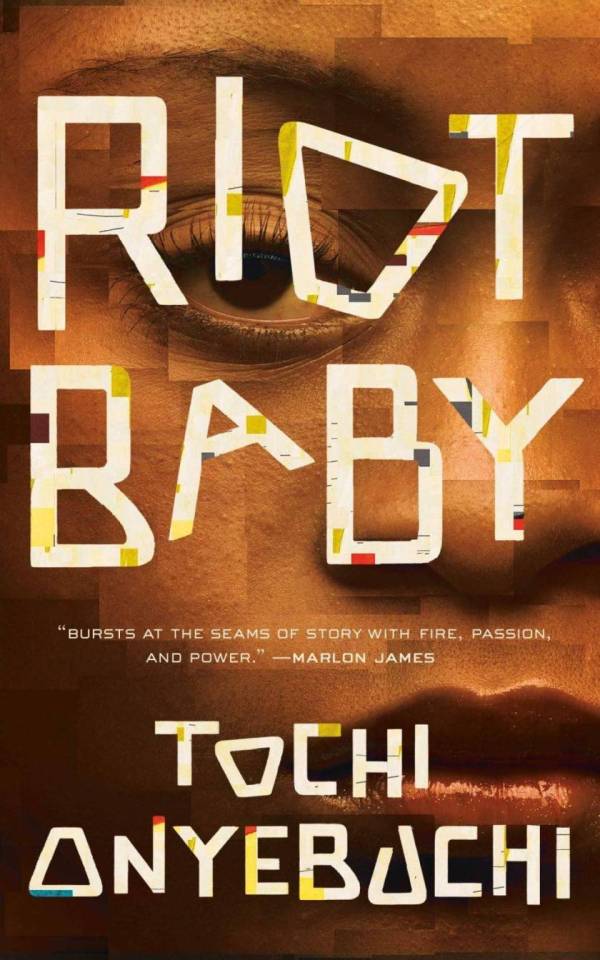
II. RIOT BABY by Tochi Onyebuchi: An incandescent Afrofuturist novella that connects the Rodney King uprising with contemporary struggle, pitting supernatural powers against dire politics.
https://pluralistic.net/2020/04/23/riot-baby/#Tochi-Onyebuchi

III. OR WHAT YOU WILL by Jo Walton: A metafiction about the desperate attempt of a character to pull his writer into a fictional world to save the both from human mortality.
https://pluralistic.net/2020/07/07/little-bro-with-snowden/#metafiction
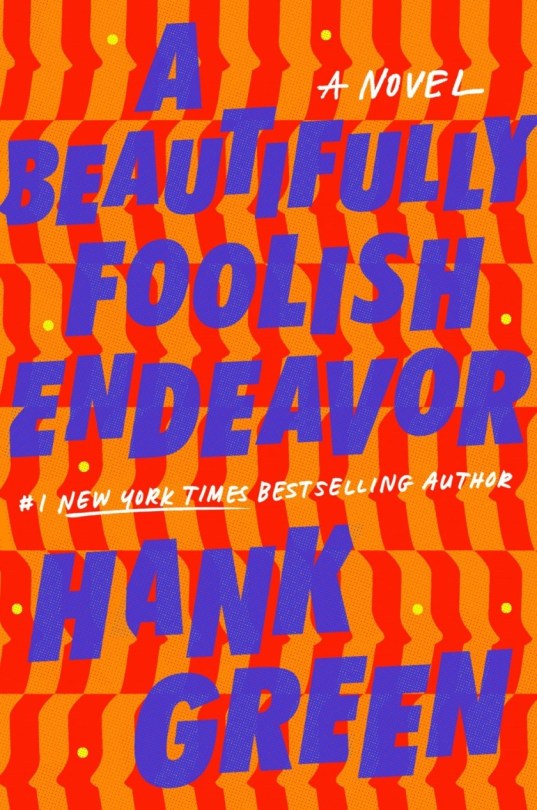
IV. A BEAUTIFULLY FOOLISH ENDEAVOR by Hank Green: Sequel to An Absolutely Remarkable Thing - a madcap and sometimes brutal tale of social media influencers, alien invaders, disinformation, and runaway capitalism.
https://pluralistic.net/2020/07/08/absolutely-remarkable-thing/#carls

V. FAILED STATE by Christopher Brown: A legal eco-thriller that imagines the end of capitalism without imagining the end of the world - cyberpunk meets ecotopianism, with anarchist jurisdictions, show-trials, and rewilding.
https://pluralistic.net/2020/08/12/failed-state/#chris-brown

VI. AFTERLAND by Lauren Beukes: Eerily well-timed road-trip novel set after a prostate-cancer plague wipes out nearly every man on Earth, except for the protagonist's teenaged son, who is now being hunted by the (all-female) US government.
https://pluralistic.net/2020/07/28/afterland/#XY
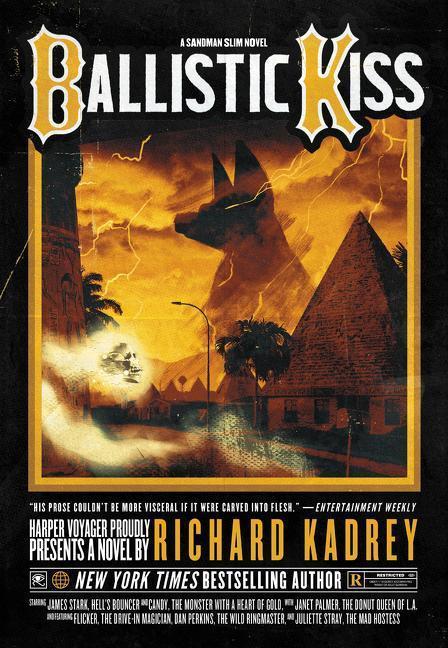
VII. BALLISTIC KISS by Richard Kadrey: Sandman Slim confronts the worst demons of all - his own trauma and self-doubt.
https://pluralistic.net/2020/08/25/anxietypunk/#bk

VIII. SQUEEZE ME by Carl Hiaasen: Hiaasen was writing comedic whodunnits about improbable Florida Man types decades before the memes, and his Mar-a-Lago gator plague novel is a hectic and hilarious tale for our times.
https://pluralistic.net/2020/10/05/florida-man/#disappearing-act

VIII. The Ministry for the Future by Kim Stanley Robinson: KSR says it's his last novel and I say it's the book he's been training to write all his life. If you like your climate fiction wrenching but still uplifting enough to move you to tears...
https://pluralistic.net/2020/12/03/ministry-for-the-future/#ksr
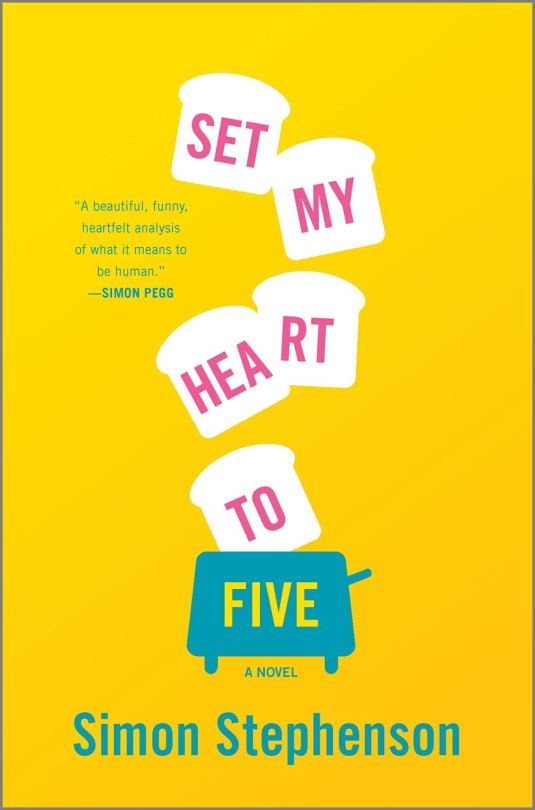
IX. SET MY HEART TO FIVE by Simon Stephenson: An absurdist robot-romp in the mold of Kurt Vonnegut about a robot who catches the disease of emotions and tries to treat it by moving to Hollywood to write screenplays about robots.
https://pluralistic.net/2020/09/01/cant-pay-wont-pay/#robot-rights
Part 2: NONFICTION FOR ADULTS
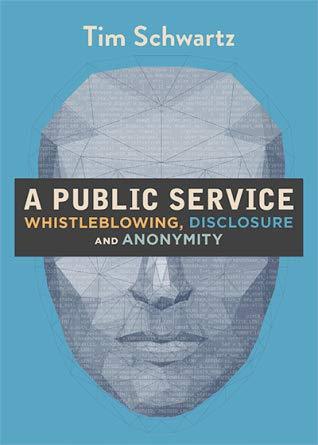
I. A PUBLIC SERVICE by Tim Schwartz: An incredibly practical, detailed guide for would-be whistleblowers (and journalists who work with them) to staying safe while spilling the beans.
https://memex.craphound.com/2020/01/08/a-public-service-a-comprehensive-comprehensible-guide-to-leaking-documents-to-journalists-and-public-service-groups-without-getting-caught/

II. THE MONSTERS KNOW WHAT THEY'RE DOING by Keith Ammann: A sourcebook for RPG game-masters explaining how different kinds of monsters can use a variety of combat tactics that add depth, texture (and challenge) to your games.
https://memex.craphound.com/2020/01/10/the-monsters-know-what-theyre-doing-an-rpg-sourcebook-for-dms-who-want-to-imbue-monsters-with-deep-smart-tactics/
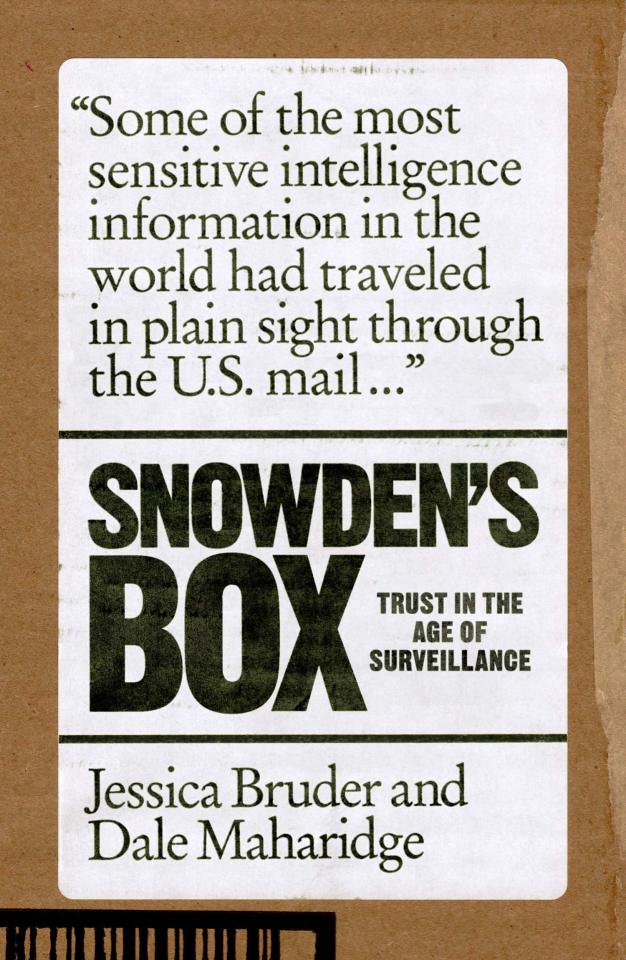
III. SNOWDEN'S BOX by Jessica Bruder and Dale Maharidge: The incredible, true tale of how trust among friends allowed Snowden's leaks to safely transit from his home in Hawai'i to the hands of Laura Poitras and the journalists who reported the story.
https://memex.craphound.com/2020/03/31/snowdens-box-the-incredible-illuminating-story-of-the-journey-of-snowdens-hard-drive/

III. ABOLISH SILICON VALLEY by Wendy Liu: A personal journey from a fully bought-in believer in Silicon Valley's meritocracy to a ferocious critic who demands tech to serve humanity, not a human race in service to the tech industry.
https://memex.craphound.com/2020/04/14/abolish-silicon-valley-memoir-of-a-driven-startup-founder-who-became-an-anti-capitalist-activist/

IV. THE CASE FOR A JOB GUARANTEE by Pavlina Tcherneva: A fierce little book setting out an economic program to rescue the nation and the planet from a system that insists we can't even hope for a better world.
https://pluralistic.net/2020/06/22/jobs-guarantee/#job-guarantee
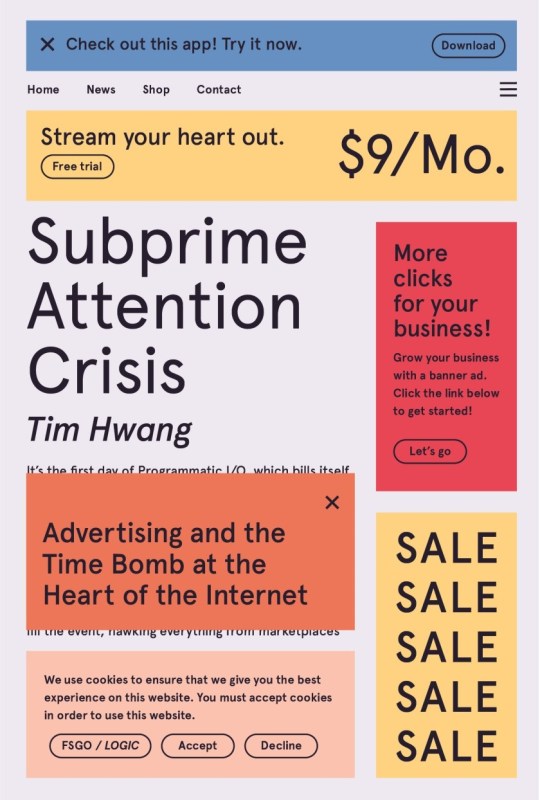
VII. SUBPRIME ATTENTION CRISIS by Tim Hwang: What's worse than having our lies destroyed by surveillance to manipulate us with ads? Having our lives destroyed by surveillance in order to fuel a fraudulent market in ad-based manipulation.
https://pluralistic.net/2020/10/05/florida-man/#wannamakers-ghost

VIII. MONOPOLIES SUCK by Sally Hubbard: There are plenty of *great* books about monopolies and the resurgence in antitrust, but Hubbard's is the most practical, providing the reader with excellent advice for actually *doing something* about monopolism.
https://pluralistic.net/2020/10/27/peads-r-us/#sally-hubbard
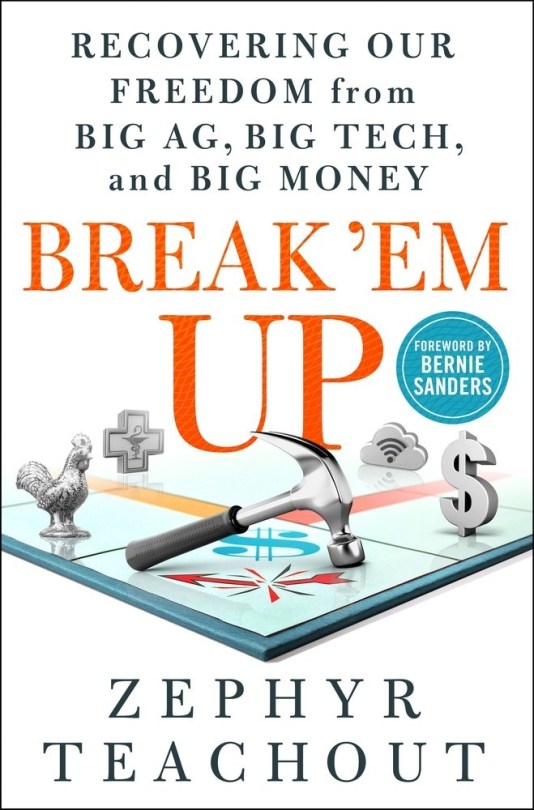
IX. BREAK 'EM UP by Zephyr Teachout: The most lucid, readable, infuriating, energizing book on the rise of monopolies. Teachout never loses sight of the systemic nature of the problem, even as she uses individual stories to tell the tale.
https://pluralistic.net/2020/07/29/break-em-up/#break-em-up

X. BOUNDLESS REALM by Fox Nolte: There has never been a better book about the Haunted Mansion (indeed, this is one of the best books ever written about environmental design in general). Nolte goes *way* beyond trite wisdom about "storytelling."
https://pluralistic.net/2020/11/09/boundless-realm/#fuxxfur
PART 3: GRAPHIC NOVELS

I. YEAR OF THE RABBIT by Tean Viasna: A graphic memoir of Viasna's harrowing boyhood during the rise of the Khmer Rouge in Cambodia. It's a tale we've rarely seen through the eyes of a child, and brilliantly realized.
https://memex.craphound.com/2020/01/22/year-of-the-rabbit-a-graphic-novel-memoir-of-one-familys-life-under-the-khmer-rouge/

II. FEMALE FURIES by @misscecil: Castellucci uses an obscure and anachronistic all-woman cast of DC Universe b-characters to tell an incredible, smart, pitiless story about #MeToo, comics, solidarity and betrayal.
https://pluralistic.net/2020/06/29/female-furies/#apokolips-now

III. LONELINESS OF THE LONG-DISTANCE CARTOONIST by Adrian Tomine: A memoir of intensely felt impostor syndrome, a forceful reminder that comparison is the thief of joy - and that the traits that keep an artist going at first go toxic over time.
https://pluralistic.net/2020/07/21/the-thief-of-joy/#tomine
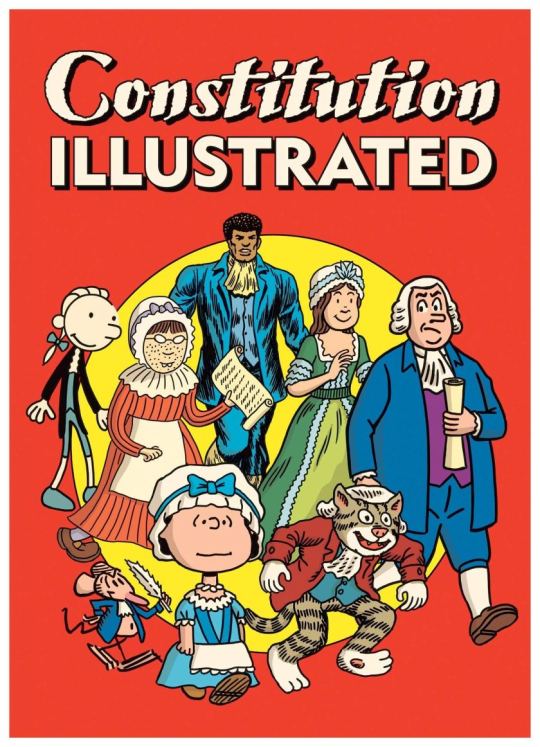
IV. CONSTITUTION ILLUSTRATED by R Sikoryak: The Trump years were an unhappy crash-course in Constitutional law, but Sikoryak's genius adaptation of the Constitution in the style of dozens of cartoonists is a pure delight.
https://pluralistic.net/2020/07/27/ip/#r-sikoryak
PART 4: KIDS AND YA

I. SEND PICS by Lauren McLaughlin: A YA novel that's a thrilling revenge-play about "revenge porn," a cyber-heist novel that's also a sneaky and forceful book about teen girls' sexuality.
https://memex.craphound.com/2020/04/21/send-pics-ripping-brutal-amazing-novel-about-teens-sextortion-revenge-and-justice/
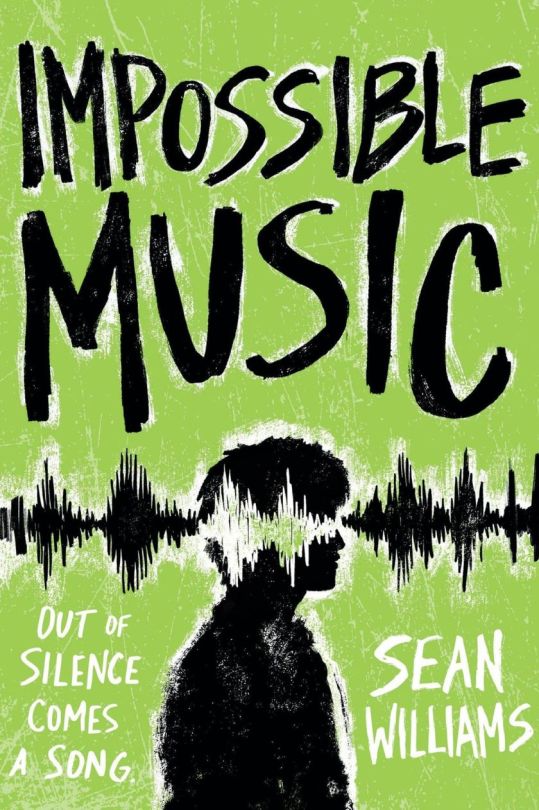
II. IMPOSSIBLE MUSIC by Sean Williams: A YA novel about a music-obsessed kid who loses his hearing is the frame for a book about ability, adaptation, music theory, family, Deafness and what dreams are really for.
https://pluralistic.net/2020/06/30/deafhood/#impossible-music

III. HARD WIRED by Len Vlahos: A 15 year old discovers the truth behind bizarre dysfunction of the world around him: he's an AI in a sim, and the guy he thinks of as his long-dead father is actually the research scientists who created him.
https://pluralistic.net/2020/08/31/ai-rights-now/#len-vlahos
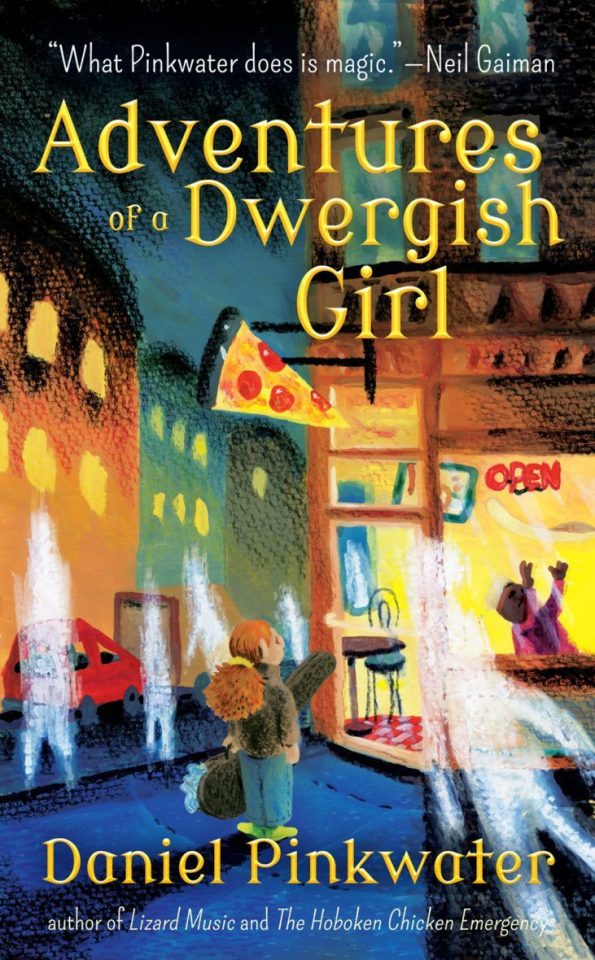
IV. ADVENTURES OF A DWERGISH GIRL, by Daniel Pinkwater: Like every Pinkwater novel, it defies description, it is brilliant, and it is his best to date. Ghosts, Revolutionary War fleshbots, papaya juice, and supernatural beings from the Catskills!
https://pluralistic.net/2020/09/25/dwergish-girl/#you-are-a-pickle
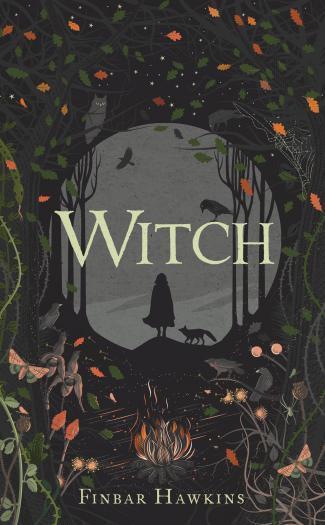
V. WITCH by Finbar Hawkins: A beautiful debut novel about a pair of 17th century sisters who avenge themselves against the witchfinders that murdered their mother. A superbly told historical.
https://pluralistic.net/2020/10/01/the-years-of-repair/#witch
FINALLY: I published *four* books in 2020!
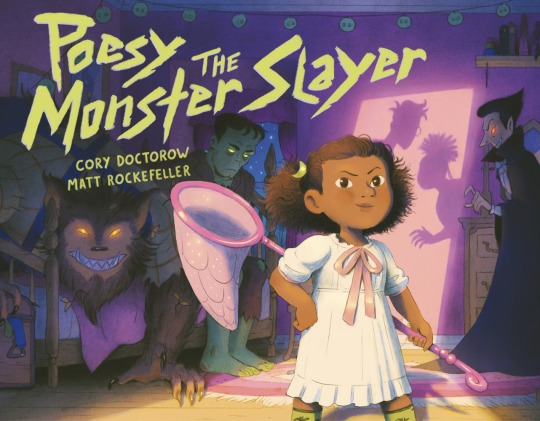
I. POESY THE MONSTER SLAYER: My debut picture book, about a little girl who turns her toys into weapons and torments her parents by hunting monsters all night, with wonderful art by Matt Rockefeller:
https://us.macmillan.com/books/9781626723627
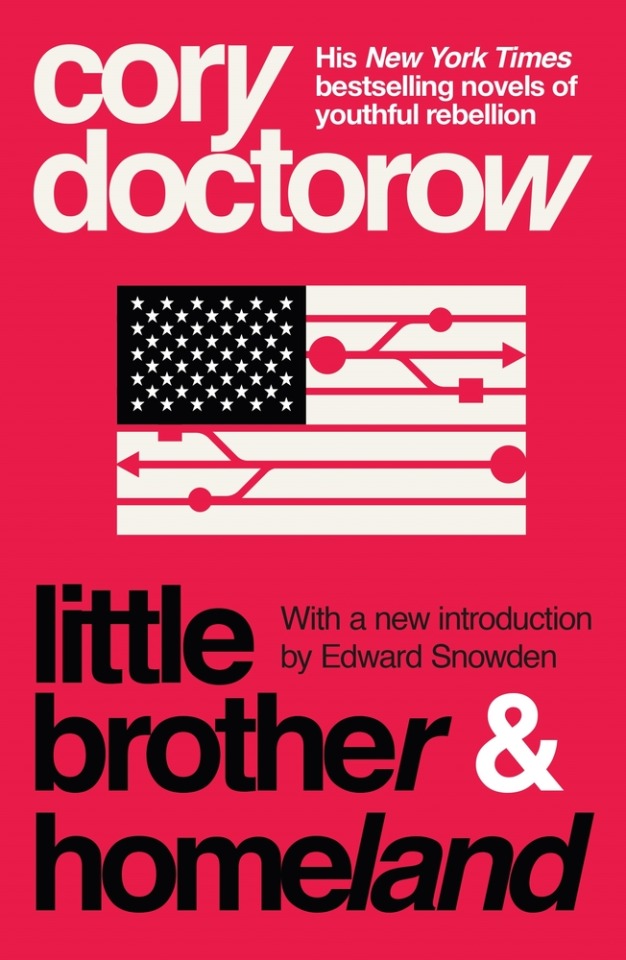
II. LITTLE BROTHER/HOMELAND: My multibestselling YA novels were reissued last summer in a gorgeous package with a (fantastic) new introduction by Snowden.
https://us.macmillan.com/books/9781250774583
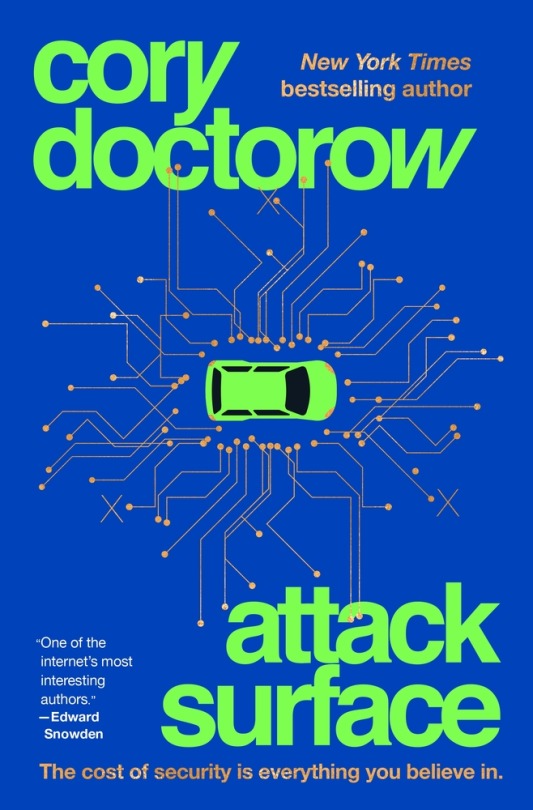
III. ATTACK SURFACE: A standalone, adult sequel to Little Brother and Homeland. The New York Times called it "vocal and unflinching" and "ultimately optimistic"; the Washington Post called it a "riveting techno-thriller."
https://us.macmillan.com/books/9781250757531

IV. HOW TO DESTROY SURVEILLANCE CAPITALISM: A long pamphlet/short book that makes the case that Big Tech manipulates us and spies on us because they have monopolies - not because they've developed devastating, data-driven mind-control.
https://onezero.medium.com/how-to-destroy-surveillance-capitalism-8135e6744d59
51 notes
·
View notes
Text
Hyunjin - Hybrid AU!
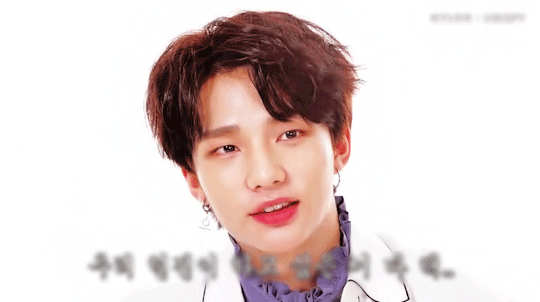
being popular wasn’t something you looked forward to when entering college, but it happened
now here you were making necks twist to watch you walk down the hallway
that’s what you get for being one of the few humans in a hybrids-inclusive college
most people wouldn’t even consider applying to study here after it became pretty much ruled by hybrids, but you didn’t mind
you like your course, you like your teachers, and your colleagues, even though they follow you around making you look like an idol or something
you entered your classroom already knowing that your favorite seat will be vacant with candies or a snacks on top
“oh, there’s cards too” you smiled reading the cheering words from your admirers
since day one boys and girls go out of their way to please you somehow
need a pen? here’s seven! hungry? let me buy you the entire menu! need a ride? you can have my car!
it’s been a year and a half, but you’re still not completely used to it
they’re so nice to you because you’re human, sometimes you wonder if that’s the only reason for it
hybrids were created to be men’s pets and obey their orders, but after decades of evolving they began conquering their own space
yes, some still prefer to be companions, but others are trying to live life in society like normal human beings
however, their genes still make them bow to human’s will, and it bothers you because you feel like you’re taking advantage of them most of the times
“good morning” your Medieval English Literature teacher entered the classroom and you put your stuff down to start your day
“I’m dead tired” Lia, a sheep hybrid and one of your closest friends, said plopping her head on the library table
you both decided to study together for your Shakespeare on Contemporary Media exam, which would be in two days
“I’m seeing Shakespeare everywhere, I’ll probably won’t even flinch if his ghost shows up in front of me”
“thou comest in such a questionable shape” you quote Hamlet in a funny voice, earning a laugh from Lia
“hopefully he won’t tell me to murder anyone” Lia’s ears were hiding in the curls of her black hair and you knew she was really tired
“go rest, Lia, we can study more tomorrow”
“yeah, guess I’ll do that” Lia gathered her belongings “you’re staying?” she asked
“uhum” you sighed, stretching your arms above your head “I still need to finish my paperwork for Mrs. Ray”
“good luck” Lia raised her eyebrows “see you tomorrow”
“see ya” you smiled seeing Lia leaving the shared study room
you decided to move to the single tables on the common area of the library because they were closer to the bookshelves
you shoved your stuff quickly into your backpack and left
fortunately there was almost no one at the library at night, so you could choose which table was best, setting your backpack on it
not far away from your table, though, someone was thoughtfully observing your every move
Hwang Hyunjin was the librarian’s assistant this semester
he was a shy and awkward alpaca hybrid, but in love with you, like everyone else in this college
although he doubted anyone liked you more than him
he felt his heart beating faster when you walked towards his counter, but you turned right on the English Literature aisle
Hyunjin let out a short breath, running his fingers through his hair to calm him down
you didn’t even notice him, why was he so nervous?
you returned from the aisle with two books and sat down, allowing him to admire your profile
Hyunjin could only stare from afar, wishing one day he’d be bold enough to say hi
you were so beautiful, your skin so smooth without any fur or scales
his fingertips itched to touch you, to feel your warmth, to caress your hair and be intoxicated by your scent
Hyunjin muffled a wail watching you so close yet so far from him
it was slowly killing him inside knowing that it wouldn’t take long for another hybrid to ask you out
and what if you say yes? what if the hybrid asked to be your pet? or even worse, what if you become their partner?
oh, Hyunjin was dying thinking about these things
but there you were, focused on whatever work you had to do, unaware of your effects on the poor boy
you were so smart, so dedicated, Hyunjin felt himself falling harder in love
not too long after, you got up again to adventure yourself on the the same aisle
Hyunjin tried to take a peek at your table to see what you were working on, but his counter was a bit too far for that
he did, however, draw what he could see from the two books you got on a random piece of paper just to check them out later
maybe if he read what you’re studying, he might have a topic of your interest to start conversation someday
he was waiting patiently for you to show up with another book, but that didn’t happen
you were taking too long for a simple task such as grabbing a book, Hyunjin got worried
he got up from his seat and went after you
he entered the English Literature aisle only to see you on your tiptoes, right arm stretched out, struggling to grab a yellow book from the top shelf
the boy let out a funny noise unconsciously, calling your attention to him
“I-I’m sorry” he said looking at his own feet, babbling “I didn’t mean to spy on you, but you’re here for quite some time, so I came to check on you, and, well, you’re short and I’m sorry again but it was really really cute seeing you try to reach that book over there, and I’m really tall, so maybe I should grab it for you?” he moved towards you, still staring down, and easily pulled the book you wanted, handing it to you
Hyunjin was embarrassed, but with your cheeks burning from the proximity, you were even more
“thanks” you replied sweetly, finally being able to see his face because he was brave enough to look at you
“you’re even more adorable up close, oh God, I’m going to die” Hyunjin placed his hand on his heart, closing his eyes and holding his breath
you would laugh at his dramatically cute reaction if it wasn’t for a wild boar hybrid interrupting you two
“yo, llama boy, where’s Kafta’s books?” the guy towered over you two, but you didn’t feel intimidated at all
“i-it’s o-over there in the-the-the German section” Hyunjin stuttered a lot, but pointed to the right direction
“I’m gonna need help with this paperwork, alright?” his words actually meant: you’re doing it for me
Hyunjin only nodded in fear, trying hard to stop shaking and humiliating himself even more in front of you, ruining any tiny chance he ever had with you
that’s when you saw the dude’s smile of satisfaction, and you couldn’t take it anymore, you had to confront him
“hey, idiot, he’s an alpaca, not a llama, can’t you see his small ears and fluffy hair? Besides, it’s Kafka, not kafta, you uncultured swine”
the wild boar hybrid was taken by surprise and lowered his ears in respect to you
“I’m sorry” he said almost whispering
“you better be! now go write your own paperwork and leave Hyunjin alone” your glare made him go away in a blink of an eye
“y-you didn’t have to…”
“it’s okay, I know he’s been an asshole to you, I had to do something about it”
“you know?” Hyunjin’s neck got red “wait, you know my name too?”
“yeah” you replied holding the book tightly against your chest, blushing even more
no one knew, but he was your long time crush and you were getting tired of just stalking him around college, so you thought it was the right time to finally confess your suffocating feelings for him
“is it weird if I say that I sometimes go to the coffee shop at the Arts building just because I know it’s your favorite place to hang out? and that I’m studying at the library almost everyday this semester because you’re here?” you let out an awkward laugh
“aaand that I’ve been trying to find any excuse to talk to you, but I never think of the right thing to say, so I end up giving up? and that maybe I’m dying to go on a date with you if you want to?”
was Hyunjin hearing things right? you were not only saying that you like him, but you’re asking him out?
oh, this is probably the best day of his life!
out of all of the hybrids you liked him? the shy alpaca whose special trick is spitting long distances?
the one who cries every night for being away from his family group?
who whines all the time to himself for being too awkward to have friends?
who dies everyday seeing his crush walking around the campus thinking he’ll never have a chance?
he was nothing special compared to the other hybrids, but here you were in all your adorableness confessing your feelings
he could at least muster up some courage and say something, right?
“how about…” Hyunjin cleared his throat to avoid stuttering, he was so nervous, he felt like his heart would leap out of his chest
“how about we go grab a coffee, then?” as soon the words were spoken, his eyes got sad “oh… nevermind, I forgot I have to close the library tonight”
you wouldn’t let this golden opportunity pass by so easily, so you smiled at him
“it’s fine, I’ll go first and order for us before they close too”
“are you sure? I mean…”
“yeah, don’t worry about it” you smiled again to reassure him
“oh, okay, well, I usually have-”
“a hot chocolate with extra toppings and a slice of quiche” you interrupted him
Hyunjin’s eyes were wide
“I notice you, Hyunjin” you shook your head “I’ve been noticing you for a long time… too long, to be honest” you admitted
the boy was at loss for words
how was this happening? was he dreaming? the person he likes likes him back? what? what was he supposed to do now? he never thought his biggest wish would come true
“can you wait a bit?” Hyunjin left the aisle quickly, running back to his counter and screaming at the top of his lungs that the library night shift was over
you couldn’t believe Hyunjin was kicking everyone out thirty minutes earlier
you laughed seeing him smiling so brightly for the first time, and your heart was filled with joy for you were the reason behind it
Hyunjin was exultant, barely able to contain his long awaited happiness
he was on cloud nine, over the moon, on top of the world, on seventh heaven… he was feeling it all!
you not only notice him, but want to be with him, the shy, awkward alpaca hybrid
what else would Hyunjin wish for besides being loved by you?
#i almost didnt post this today#my wifi sucks#stray kids imagines#stray kids scenarios#stray kids blurbs#stray kids drabbles#stray kids AU#stray kids hybrid#stray kids#skz#hyunjin#5/9#190518#kpop scenarios#kpop imagines#kpop AU#kpop hybrid
1K notes
·
View notes
Photo

Would you like to become a better writer? Hi there, my name is Oren Cohen, and I've been writing blog posts, contemporary stories, and speculative fiction for over three years now. The one thing that always eluded me was building a community. I've had many people read my work on websites like Medium or other blogs around the web. But I never created an engaged following on social media. The reason was that I struggled and still struggle with crippling debt. I always felt as though I'm in a race against time. On paper, it seems as though a thousand sales of my writing course will put me in a much better position than I am today. It will allow me to pursue writing as a more prominent part of my life instead of thinking about paying the bills. But when all you think about are your bills and surviving month to month, you tend to be inconsistent with your work. Recently I was reminded again that giving is more potent than taking. I do not live on the street, thank god, and I also have a day job. It's just my dreams that are moving away from me. And there is nothing worse in life than living with the lingering emotion of regret. If I don't do something to skyrocket this writing dream, then I will always regret it. We don't know each other. And yet, I choose to give you my knowledge, my experience, a part of my life. I don't ask anything in return because I know that the world works in mysterious ways. I sent out my wish to be free of my debt to pursue my dreams into the void, and now I will keep on doing what I love - writing, blogging, forming ideas into words, and words into worlds. And will give it all to you, dear reader. May we grow together in power. I don't claim to be the all-knowing expert. But I have picked up some things along the way from professional writing workshops and my research on the art of storytelling. Perhaps those will be helpful to you. Expect posts every day except Friday at 10 AM EST, with the first one soon. #writing #fantasy #writingcommunity #creativewriting #fiction #bookstagram https://www.instagram.com/p/CGu6ioSitab/?igshid=dg27da7wwr3m
1 note
·
View note
Text
When you are still talking about a show you are too old for..
warning: it’s loooong (TL;DR section at the bottom)
Just to be clear I have no intention to look into and review any more Winx Club related content and it’s not just because the current environment is not conducive to this kind of endeavor. After I finished paying off my debts I considered getting back to this but eventually decided against it because some of my thoughts regarding this show have changed a little and I overall no longer see the point. One of the things I wanted to accomplish when I first started was to figure out why this show never appealed to me when it first came out on the FoxBox and well, the answer was very simple if not ridiculously obvious. This show was not made for me.
I was a few months short of 13 when the show premiered in the US and had just enough experience in the genre to have expectations, and this was the problem. When western magical girl series started to show up in the early 2000s, I expected shows that improved upon the standards and cliches left by the likes of Sailor Moon and its genre contemporaries, not just in terms of visuals but writing as well. Winx Club however, seemed more in line with the type of cartoons that (since the 80s) popped up every now and then as promotional material for emerging lines of fashion dolls generally targeting younger girls, with the only difference being that it had a progressive story-line. Even if you argue that Winx Club was not so merchandise-driven in its first seasons, contemporary fashion and aesthetics had always been the selling point. By then, shows that prioritized visual appeal over writing and seemed to exists primarily as toy commercials, were starting to lose my interest. I was also getting tired of certain staples like romantic relationships being bland but senselessly overemphasized and characters (specially protagonists) being archetypes with little to no complexity.
As an adult, I since looked back at shows of similar quality/target audience and I have surprisingly been able to find joy within them leading me to another conclusion. It’s not that I am too old and weary to appreciate animated media aimed at young girls. It’s more likely that Winx Club is a sore spot for me because it is the show that made me realize (if subconsciously) that networks in charge of delivering animated media to mainstream television were no longer invested in appealing to me. As a non-white, lower-middle class girl who was never all that into relationship-melodrama I felt that most cartoons of my day didn’t really catered to my interest and I think I saw the rise of Winx Club as a bitter indication that even the animated genres that I liked or tolerated would eventually become completely inaccessible to me.
I had some trouble finding out what the target audience bracket was for the first season. From what I eventually gathered it is either 4-8 or 5-10, although apparently concept-wise the show was intended for a slightly older age group. I give more credence to the first bracket because honestly I think this show works best as baby’s first magical girl series. The less experience you have in the genre, the less fed-up with tropes and the less expectations you have going in, the better.
Lets just make a thing clear. There is no such thing as being too old to watch cartoons. An art medium is not inherently tied to an age group. Unfortunately, everything is at the mercy of capitalism, specially art produced for entertainment. There is a lot of stupidity and outdated ideas governing how mainstream shows are made and to whom they are made for. Industries don’t like to take chances and they are reluctant to change in accordance to society unless an increased in profits can be assured to some degree…
Look, look! I swear I was just going to post a simple paragraph-long note to whoever cared, stating I was not going to continue reviewing Winx Club even though I am no longer in debt. But, I made the HUGE mistake of looking at the Wikipedia page, specifically the part where they quoted show creator Iginio Straffi defending the controversial choices made for season 8, and here I am, annoyed and rambling. To paraphrase, he claims kids around 10 years and older just don’t watch cartoons as much as they used to (sure, Jan) and they just had to retooled their show for a younger demographic and that just means it cannot be as complex as it used to be. Yes, complex is a word he ascribed to the earlier Winx Club content (level of complexity to be clear). I rolled my eyes, I died a little inside and overall I also decided, among other things, to never read another Iginio Straffi interview ever again.
In an effort to wash away this BS and exorcise some demons let me throw here some of my still lingering unwarranted Winx Club thoughts in no particular sequence before this platform collapses any further:
Winx Club is one of if not the longest running western magical girl group series and its success is likely attributed to the fact that back when it premiered in the US, it was the only accessible and visually appealing series to come out of the genre since the beginning of the millennium. It practically had a monopoly of its intended audience. In my neck of the woods, it was available without the need of a cable/satellite subscription. In contrast, Dinsey-owned W.I.T.C.H. didn’t have that same accessibility and I don’t think I even need to bring up anime in general. The one other magical girl show from around the same time that I remembered coming across in syndicated broadcast was Trollz, and well you look that up and tell me how much staying power that looked like it had.
If the show has struggled in recent years is of course NOT because older kids don’t watch cartoons nowadays. Rather I think the show runners are not quite grasping how the circumstances surrounding their target audience have changed since the early 2000s. There are a lot more options out there in terms of entertainment even if you narrow things down to only western magical girl cartoons, not to mention that Winx club no longer has an edge on accessibility. I also think we consume media faster and that along with all the new options of entertainment means we have less head space to dedicate to one single show. Putting a new coat of paint to the newer seasons is simply not enough to remain relevant.
Adding to the above, It’s been well over ten years since the show first premiered. I don’t have data to prove this, but I am willing to bet that a sizable chunk of viewers were there from the beginning or joined at the start of the Nickelodeon era. It makes little sense for changes in writing to include hacking its continuity, rewriting established lore and deleting whatever meager character development they ever had. Maybe it’s not a good idea to turn your show with progressive storytelling including aging characters, into a cash cow you intend to milk for as long as you can and beyond. Maybe they should have given the early seasons a proper conclusion and laid the groundwork for new groups of characters to lead fresh series within the same universe...or you know, a full reboot.
I am not saying that the show should suddenly conform to my tastes (though that would be nice) after all it was not made for me. I just think that people that stuck with it deserve more than what they have been getting. I saw some positive feedback with regards to World of Winx but from what little I saw I don’t think it was good enough to be the series for older fans. Tone might be slightly different but writing-wise it feels more or less the same as the current series. The attempts at humor are still not landing for me at least. Also, how old does Straffi thinks the older fans are? 10? Who knows, maybe season 8 did its job in drawing-in the next gen, and maybe the planned live action series will be all that the older fans have been asking for. I do wish them the best.
Regarding things that I changed my mind about (though only a little bit)...In more than one occasion I referred to Bloom as a mary sue and this has been digging at me. Either the term has become toxic and too often unfairly assigned to any female character in a leading position, or it was always an improper way to discuss mediocre writing. There are main characters that are created in part to serve as vehicles of indulgence for its intended audience. I don’t think these these type of characters need to be complex to be successful or serviceable but I do think relatability and/or likability are indicators of whether or not a specific indulgent protagonist is effective. I didn’t find Bloom to be effective but she seems to be popular enough with the younger range of fans and that’s what matters. All I am saying is that Bloom could have easily been better and all it would have taken was for the writers to slightly lower the pedestal they put her on. Otherwise, they should have just stuck with the Magical Bloom title so no one would have delusions that the show would ever focus on anyone else.
I stand by most of my other major criticisms of the series. Though I admit that when I was looking at each episode I would spend an unreasonable amount of time on small things or personal pet peeves.I maintain however that to whom a show is intended for should not be a determinant of quality and there are things worth discussing even if one is not within the age-range of said audience. However, it’s not hard to tell what Winx Club is mostly about; it’s romance-centered. If you are not all that invested on that sort of stuff or you don’t like what the show is offering, then there is little point in sticking around because you are just going to get more and more caught-up on the flaws. The fantasy world elements while ambitious in scope are not well developed and consistency is an issue since the beginning that only gets worse as the series goes on. Unless you can subsist solely on the aesthetics and merch-friendly elements, I wouldn’t bother beyond the first movie.
If Winx Club had been the definitive blue print shaping the future of western magical girls shows, I would probably feel justified in making this much of a fuss. However, pretty much any other show I have seen after the fact has been a deviation and an improvement. I believe that’s because more content creators that grew up with the genre (and understood the many ways it could be improved) are finding opportunities to bring their appreciation for it into the mainstream. It’s pointless for me to still complain about the older stuff. Heck, I can even find good things to say about Angel’s Friends and this is definitely a cartoon that was shaped by the success of the fairy school show.
Winx Club is fine, it has as much right to exist as any other piece of mindless entertainment aimed at any demographic. And that’s that.
TL;DR
I am not reviewing Winx Club stuff anymore. I just had a lot of thoughts that were brought up by an annoying Iginio Straffi quote I saw on the Wiki page while I was working on that last post. Extended rambling is what I apparently do when I am mildly upset. I barfed all this out in the hopes that I won’t think about this show again anytime soon.
If morbid curiosity gets the better of me, I might give future Winx Club content a watch. I just won’t post about it because it seems I am incapable of finding joy in it.
No, I don’t take criticisms of the bad spelling/grammar of my ramblings. Let this mess be. This is also not a place for debate, the only discourse I welcome here is whether or not relatability is a word. Online dictionaries say it’s fine but my word processor says it is not a thing. Discuss! (JK)
Stay safe,
#winx club#ramblings#winx club review#cartoons#i am too old#winx#anyone ever heard of Angel's Friends?#I am either watching that next or Lady LovelyLocks#por que no los dos
5 notes
·
View notes
Text
The Internet Is Not Remarkable | Which Is Why It’s Remarkable
Oddly I’ve not ever felt the need to unplug. I don’t have a sense of separation between life happening away from the Wire and life happening on the Wire or the Wire not being life. It was never a distinct thing I ever had to decide was or wasn’t life or became life, either. Being born in the early 80′s, I guess means the Wire wasn’t always there as a salient presence, integrated into the fabric of life. Heyo I had a Nokia 3210. That doesn’t mean anything, by the way, it just places me on a timeline. Nostalgia sucks and is literally valueless. Let’s make art you can steal.

Anecdotally it means I saw the internet happen as a Thing. It’s less important than it sounds. Also the internet going from not being a Thing to being in our pockets. OK. But honestly it’s not very important. As in the transition isn’t important. There were a lot of people there when it happened and I think a lot of us if and when we’re honest will tell you now, in retrospect, it’s not a big deal. People older than I am and some my age and younger who have an ignorant and uninformed understanding of life and experience will go on about life being better or significantly more meaningful before or without the Wire but honestly they’re wrong. I’ll come out and say it’s flat better. Sure it makes misinformation easier as much as it makes all the good things better but wow media control and information mass-dissemination before the Wire? Are you kidding me?
On the topic of unplugging and digitally detoxing and I realise The 1975 just made a video all about it that was overly cute, yes, but still pretty fucken’ great. Let’s link it because honestly, it’s a wonderful snapshot of its time that they’re unquestionably aware will date immensely and that is a big part of the point. The 1975 hardly need any more promo but what can I say, I’ve no problem being part of an adoring fanbase and adore them we do. Let us adore.
youtube
That it’s so on-the-nose and that it’s a big part of the point is going to anger and frustrate people so much, moreso that exactly that reaction is a part of being caught-up in the inevitable participation in what the song and indeed, what Matty as an individual and what the band as a commercial and cultural entity are. The too cool thing to do is say you didn’t know anything about it, you didn’t watch it, you don’t care for it, you’re immune to it and continue to be ignorant of it - sure, I used to be cool like you. The thing is I both care less and more about being cool.
I love this song, I love what it’s doing and what it means. I love being a fan of and loving things. I love that other people love things I love. I still love loving things no-one knows about but I always love other people finding and loving my things, even if and when some of them behave badly because as an adult and an individual, I understand that participating in one cultural activity doesn’t mean I’m fully represented as a whole cultural entity.
Coming back to unplugging and that not being necessary for me, it connects to not being overwhelmed by it, which connects again, to the Wire not being separate and distinct from what I see as my experience of life. If the Wire is a mundane aspect of life then it’s unnecessary to disconnect from it. I engage with it as much as I engage with other things, that is to say I’m fascinated by, obsess over, and grow bored with things on it as much as all subjects, objects and activities in life equally. I don’t think this is unique to me at all, I suspect it’s quite common.
As it happens, I got into Instagram in a big way around the same time I got into contemporary board games. Both of these things I’ve almost wholly discarded. Almost, but not quite. I still maintain my Instagram account because I’ve made some valuable and enduring connections on it and as a platform I seem to have nurtured some semblance of an audience for a sprinkling of subjects and visual motifs. As for board games, I’m actually still quite interested in them but there’s so much about them as an industry and culture I actively dislike and have also grown bored of that I’ve consciously disengaged from them.
Facebook as a culture has always been weird to me, I can’t say I’ve ever understood it as a platform. Primarily it seemed to function as a space to connect with people you already know - OK. So then we’re encouraged to engage with one-another on... topics we may or may not already be engaging with either in our physical time together in which case, it’s redundant? Or we post articles we expect others to read which mostly they don’t unless aaaaaah - they’re short, reductive and in simple language and now the exercise is hazardous. The platform then actively co-opts strangers into discussions by facilitating cross-posting intra-sharing articles, which to be frank is about eyes on ads and ad-revenue, here we get to the ultimate objective of Facebook as a platform which I guess is why none of it makes any sense. Engagement at all costs. Of-course Facebook doesn’t care about racist groups and the real violence it precipitates, why on earth would that matter to them? The only thing that matters is capitalist gains. As long as it doesn’t directly cost them and as long as there are no economic consequences for them, they will proceed, and this is pervasive and transparent in the way all actions are facilitated and encouraged on the platform as a utility.
There’s more to discuss about Facebook but you’ve had those discussions before and they’re boring. Facebook is boring. The way people use Facebook is boring. Many of my peers ported to Instagram because as many of them said “It’s like Facebook but just pictures” and something along the lines of “It’s just pure” and there’s a high degree of truth in that. The sense of purity comes from the feeling of positivity in that thumbs becomes hearts - the likes an image gets. Engagement is fairly low-level. People express their endorsement of an image or do nothing at all. Occasionally there’s discussion, predominantly positive and for the most part I’d agree it’s wholesome. You can find toxicity easily enough and all of it is bad, but there are whole spaces on Instagram where you’d be forgiven for thinking it was a platform free of it altogether.

I guess it’s worth mention when I was peak Instagram, I was producing a super lo-fi but passionate board games podcast I recorded with R and we were also running several public and private board games groups around Melbourne. There was a lot of good about that sense of community and some of those people are still in our lives now. Platforms like Instagram are great for celebrating many of those aspects, I’d still say better than Facebook. Instagram is more approachable and simpler for just showing a thing and liking it - the engagement is direct and the commitment level (sign-up, visual clutter, privacy concerns, settings digest etc.) is minimal.
There are some Instagram Stories (read: Snapchat clones) there listed under This Account that briefly go thru the effective mothballing of my account. To have a different discussion here, I know how much and what kind of work it takes to build and maintain and audience on Instagram and it’s not interesting to me any more. It’s boring. I don’t mean to disrespect the audience I have there, all audiences are made up of people. Their behaviour on the platform is indicative of the cultural space that Instagram is, not their respective characters and that’s fine. That I’m bored is indicative of my feelings towards the platform and the culture it fosters, not how I feel about the people themselves. I still really like most of the people I’ve made connections with on Instagram and ping them DMs about beer, Lego and art once in a while. Instagram is about keeping it light - or lite is perhaps more appropriate - and I’m happy to keep my engagement level likewise.
That makes it extremely strange that I chose tumblr as a cultural space for my long-format writing, then, hey. Sure does. I did write about tumblr as a cultural space and honestly I still feel the same way about it - I absolutely love it here. Even tho I don’t engage in tumblr at all in the way the culture here utilises it, oddly I still feel right at home, fitting that one of the titles of the entry is Hiding In Plain Sight.
I don’t effectively have an audience for my writing here, tho, and that certainly is different. There’s a certain buzz missing from seeing a post light up with hearts, but then I think - a post gets a tally of hearts, of likes, so the people around me - my audience - likes an image and/or the accompanying text I’ve written tho that’s unlikely as the ratio of viewers to readers is likely to be extremely low. So if I think about how meaningful the text is to me versus the image, sometimes it’s split down the middle, but often the writing is far more important or at least there’s massive intent for gravitas to the image. Without the text, the image would be pleasant at best, and I realise that’s what people are engaging with and throwing a heart at, and I’m not interesting in doing that. I’m interesting in writing and expressing because I’m doing that anyway. I’m talking to and for myself regardless which I’m very happy to do, so if I’m going to do that, I’m happy to do it on the assumption of no audience and just express freely without restraint on subjects that interest me the most.
I either will or won’t develop that audience, but it will have to be with people who are dedicated enough to read and that might be a thing just yet, but who knows, there may be coming a time when people realise it’s not the Wire they need to unplug from. I’m not spinning up theories because it’s less complicated than that. I still operate a Facebook account. There’s a lot to hate about Facebook but of itself it’s mostly banal. Sure its UI and UX both are horrors that precipitate actual nightmares (unrelated but recent: none worse that iTunes MY GOD WHY WHYYYYYYYYYYYYYYYYYYYY) but from a utility perspective it can be useful in the least. I have connections with a handful of people and communities which are useful to me for the moment so until they’re not, I’ll use the platform - but my weekly usage would be measured in minutes, I’m not sure I’d make cumulative hours in seven days.
When I moved away from Twitter and Instagram, I wanted a more considered approach to everything including images. I did once take long walks in Melbourne and photograph things that I found aesthetically interesting and under the circumstances that isn’t possible. I did stop doing that much earlier than Covid19 tho but that’s due to family circumstances alluded to in other posts. I still think if I ever take up photographing things with the same regularity, those images will end up here, simply because if I want to cut in with text, I can with better control. But also because it’s more meaningful if I don’t, and also as an artefact, a html page is something that invites a more static approach to the scrolling endless feeds of Instagram and Facebook. That design is absolutely intentional to promote short engagement and continued dismissal and that’s not something I want to encourage, with mine or anyone else’s art, thoughts, responses and engagement.
I don’t think I’ve addressed how The Internet Is Remarkable, but it’s pervasive in much of what I do on and with the Wire. I think accessibility is one of the most powerful things we do as humans. I’m sure there are folks who are sick of Margaret Mead’s healed femur anecdote or at least people quoting it. I fucking love that quote. I might not like people not fully comprehending it but I sure love what it truly represents. I think something people may be surprised to hear from me is that I will never say that I don’t like people. I really don’t like the quips and memes about hell being other people or I don’t mind going outside, it’s the other people ad infinitum. It’s easy to look at a large representation of behaviour and say “People are stupid” but it’s much more difficult to sit in a room of people you know and tell them they’re stupid. I might find it increasingly difficult to find other adults with which I can engage, on subjects I and they both can and enjoy engaging on, but I both have the willingness to and the optimism that it will and should happen. A part of that is the exercise - the practice of considered expression, of thinking, language and performance. Some of that for me is writing here, some of it is in the musical instruments I play, some of it is in the oral auditory words I speak.
Fucking around is good fun, we don’t always take life too seriously - sure, but we also don’t just fuck around. If that’s all you end up being able to do, there’s so much you end up not doing, not seeing and experiencing. Imagine the only form of expression you have is to tap a heart. That’s not to diminish the power of tapping that heart - mate, smash that shit - did you see that last picture of the beers we bought? DID YOU SEE MY BEERS? Those are some champion fucken’ beers, follow my Instagram.
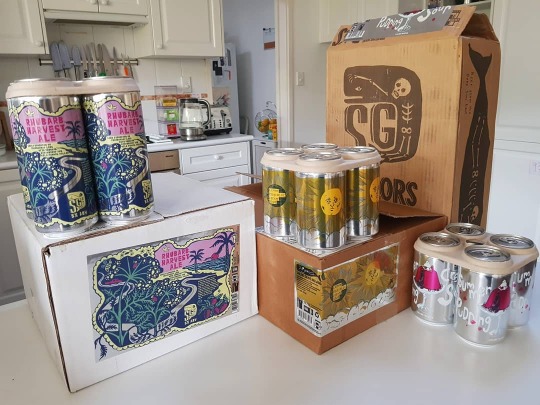
Look you might need to unplug occasionally or partially or permanently or whatever. This isn’t a sermon, I’m not talking at you, I’m talking to you or rather I’m talking to myself. I’m telling you about myself because like everything I do and typically will always mention, it’s a provocation but also an invitation to talk about yourself. We share with one another to learn about other experiences and grow perspective on our own - you get all of that. That’s why the Wire is a good thing. Accessibility to broader experiences is a good thing.
This mass documentation we’re doing? Even if no-one reads it, even if only a tiny shred of it is shared... do you realise how immense that tiny shred is? Of a billion billion billion terabytes of unread, unseen, unknown data, the tiniest fraction that gets shared between humans is still huge were it to remain hidden and secret - all the wonderful art, the ugly horror, the juvenile silliness, the unending pain and sorrow, the saccharine sweetness, the lilting playfulness, the nonsensical vagary, the bare minimalism, the overbearing eloquence, everything subjective and argued and agreed and ignored.
The internet is an ordinary book of everything made of electricity and you carry a copy of it in your pocket.
I’ll echo similar sentiments to those in the feature on Jeremy Blake. You can be an arsehole, or you be awesome and kind and we can do amazing things together.
#internet#chrono#2020#nostalgia#nostalgia is pointless#no really nostalgia has no value#steal this art#The 1975#The 1975 The Birthday Party#NOACF#Facebook#Instagram
1 note
·
View note
Photo
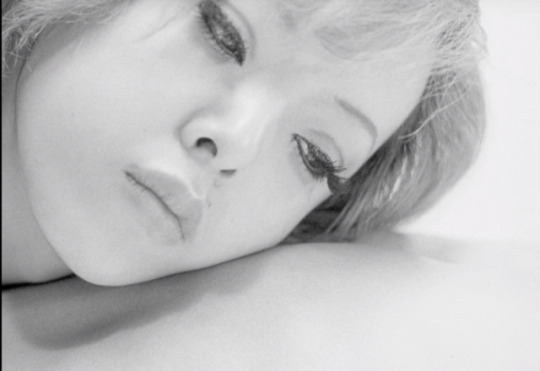

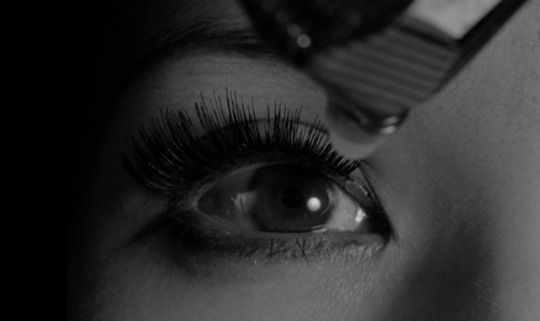

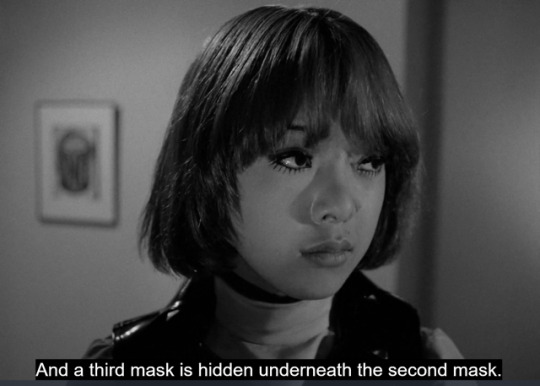

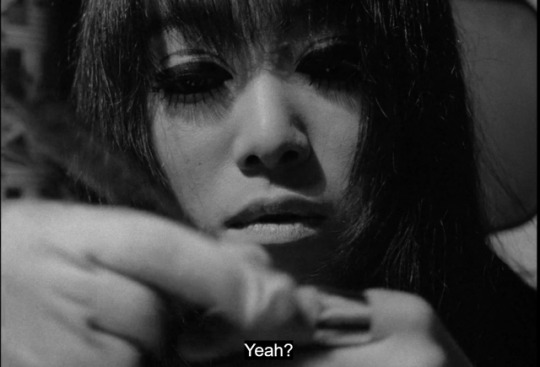
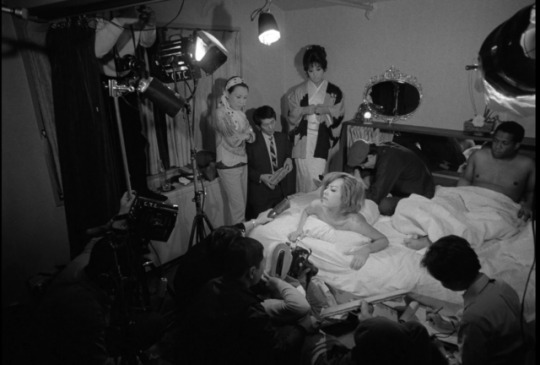
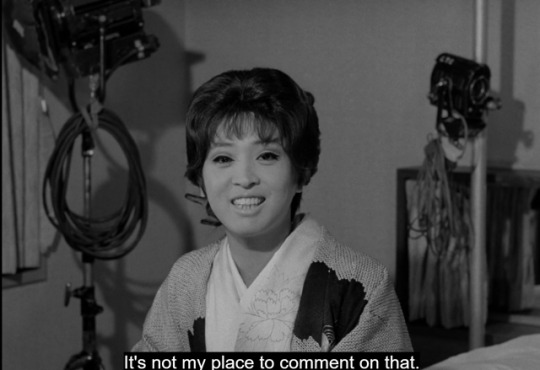
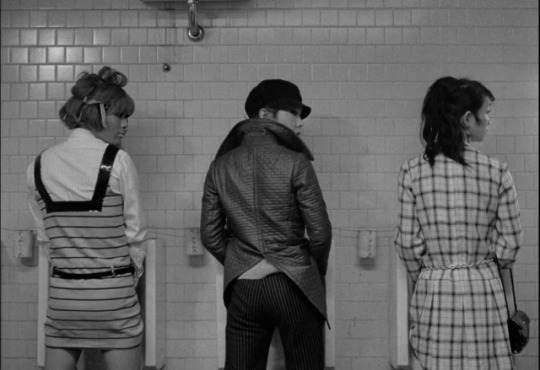
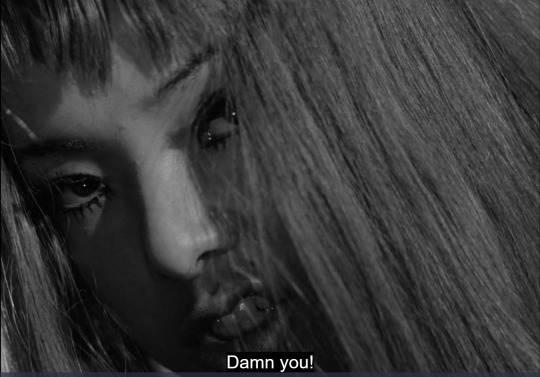



#112 Funeral Bed of Roses (1969)
Director: Tashio Matsumoto
Director of Photography: Tatsuro Suzuki
Japan
Gerow: While you eventually ended up a filmmaker, I heard that you originally wanted to be a painter. I wonder if you could talk about the relation between cinema and painting and why you decided on a career in film.
Matsumoto: Well, I loved painting. I had been painting since middle school, but Japan was very poor at the time I was about to enter college in the early 1950s. To do painting meant you weren't going to eat. Even so, I wanted to paint, but my parents were bitterly opposed to me going to an art school and said they wouldn't pay for art school examinations or tuition. In those days, there weren't part-time jobs around like there are today, so there was no way I could have done it on my own. So I gave up on art school and entered the medical course at the University of Tokyo because I was interested in the brain and problems like schizophrenia.
But even though I didn't necessarily grow to dislike that, I thought I had only one life to live and I wanted to pursue art. Without telling my parents, I changed my major half-way through to art and art history in the literature faculty. Tokyo, however, didn't really have any classes teaching you how to paint, so I studied art theory and history in school and learned painting on my own. In my studies, I learned for the first time that there was an avant-garde cinema in Europe in the 1920s that visually was deeply related to contemporary art--a fact that struck me like a bolt out of the blue. Though I couldn't see these films in Japan, I was strongly stimulated by foreign books and articles about them. I felt that this, an area where issues of art and cinema overlapped, was what I had been searching for.
Of course, I loved movies and went to see them a lot from the time I was in middle and high school. I was even treated like a juvenile delinquent and was arrested twice by the Shinjuku police because I skipped school. Well, I was that much in love with film, and I asked a friend of mine who had a stock holders pass--his father was in the theater business--to lend it to me, telling him I'd return it whenever he wanted to go. I'd go to school until noon and then go straight to Shinjuku where I'd see one movie after another, going into every first-run theater in Shinjuku from one end to another. To see all the first-run films in Shinjuku meant that I was seeing almost all the releases.
Source: yidff.jp: Matsumoto interview with Aaron Gerow
I’m not going to reconstruct the plot, because it might be more helpful for a first time viewer to reign in their expectations. So here’s my shopping list of divergent visual cues / associations that I encountered in this film:
Andy Warhol’s factory, Twiggy, Psychedelics, Victor Moscoso, Stanley Kubrick, Oedipus, Slasher films, Dada and Surrealism, Transvestites, Cinema verite, Pop art, Porn movie sets, Yukio Mishima, William S. Burroughs, David Lynch, Kitsch, Men as Geishas, Drug culture, and acid rock / carnival soundtrack.
Now, splice all this up into a non –linear narrative, and capture it in great black and white cinematography, and that’s what you’re going to get hit with for the duration of the film. Funeral Bed of Roses is an unforgettable movie on several levels.
One: This is a movie way ahead of its time. As a film that puts homosexuality front and center, this movie was half a century ahead on a topic that has only now made it safely into mainstream media, the fact that it emerges from Japan, is in some ways more startling. True, Japan does have a rich artistic tradition of merging sexuality, violence and the grotesque, but it is also known as a very traditional and highly repressed culture. Japan was also a culture struggling to artistically re-identify itself after being leveled by the fire bombings of World War II. Japan had to come to grips not only with its own past cultural heritage, or what was left of it, but also come to terms with its immanent and rapid post-war modernization.
Two: As an example of taking a somewhat bizarre and unorthodox approach to a classic myth (Oedipus), it’s not the first work of art to excavate this ominous Greek tragedy, but certainly one of the more unexpected adaptations you’ll ever see. The Oedipus translation emerges more clearly toward the end of the film, but our main character, Eddie (Pita) has issues with his condescending / abusive mother and his absent father. Because of the collage format of the film, these connections at first appear as abstract visuals with no context, but the story slowly gathers the fragments together into narrative cohesion.
Three: Stylistic treatment. From the opening visual, and really through to the finish- the cinematography is excellent. It is strong in terms of image, tonality, composition, cropping and graphic innovation, where it puts its black and white palette through a strobe -like psychedelic montage. If that wasn’t enough, there are passages of film where the male / female actors are interviewed about their homosexuality, and how they fit into this rarified part of Japanese subculture. These passages are quite beautiful, and rather disarming when we hear the blunt and deliberate answers to probing, personal questions. But these narrative and stylistic breaks add to the overall variety of visual texture in the film. Additionally, the movie is a joy to watch when it spills out onto the Tokyo streets, camera in tow. The reactions of bystanders as transvestites are filmed in a mock gang fight adds yet another unique layer to an already bizarre scenario.
Four: Picturesque eroticism. While not straightforward in its graphic representation of sex as a film like Realm of the Senses ( #31), it does treat the theme of eroticism and obsession in a visually alluring manner. Making sexuality and its accompanying psychic impulses into a visually intriguing confrontation has been with art forever, but in this film, its close stylistic counterpart is Surrealism. Literary stories like Georges Bataille’s Story of the Eye, or the sexual juxtapositions of the paintings of Rene Magritte, or Marcel Duchamp, come to mind when viewing this film. I’m not sure of the weight Matsumoto’s gives to his visual references, but whether he was channeling them or not, the Surrealists would have embraced this film immediately. They would have loved it, not only for its taboo subject matter, but for its cut-up compositional methodology.
The onset of the twentieth century saw the artistic avant–garde in both Europe and America taking the position to critique industrial culture, conservative institutions, and adapt the language of the machine age to explore emotional / sexual /psychic territory that culture uniformly tagged as forbidden. Abrasive content and uncomfortable depictions became the means for modern art to divest itself of sanitizing its messages in nineteenth century classicism, and confront its audience, however small, with some of the tangible and psychic brutalities of the modern era. With Matsumoto’s initial calling as a painter, for a film like Funeral Bed of Roses to emerge during the 1960’s makes perfect sense. At the last half of the twentieth century, two world wars, and conflict in Asia provide perfect conditions for this avant-garde film to freely pull from the file cabinet of counter-cultural iconography to piece together its unique contribution. The fifties and sixties saw the emergence of counter-culture and drugs making their way into mainstream consciousness, and this film is clearly a byproduct of this phenomenon. From its cinematic, self-referential passages to its historic allusions, it is in many ways a fledgling product of post modernism. This category /term would have been in its infancy at the time Matsumoto made this picture, but the historical and stylistic earmarks are there. Andy Warhol is often cited as the first post-modern artist. One who consciously adapted to and utilized images from commercial mass media, not merely as process, but in terms of content as well. They are very much products of the advertising / television age. Funeral Bed of Roses comes across in much the same manner, a transvestite geisha on a street corner as traffic speeds by serves as a very modern study in contrasts. Scenes of drug use and sexuality form a good deal of footage, topics and images that only a few decades prior would have been met with stringent censorship.
We get comfortable with certain expectations we have from movies. We want them to deliver certain things in certain ways, and to break these expectations is to invite scorn from the audience, or even worse, all out neglect. This is not always an easy movie to watch. Many won’t like the subject, many won’t like the treatment, many will be confused, some won’t even be patient with it being in black and white. But, this film is unique and certainly has more than its share of kooky and beautifully alluring visuals. It might be better to see it while you’re on psychedelics, I’m not really even sure about that, but that’s yet another layer this quirky film has to offer.
One of a kind.
https://filmjrnl365.tumblr.com
7 notes
·
View notes
Text
Panels Far, Far Away: A Week in Star Wars Comics 5/15/19

Scoundrels, pilots, and rebels take the spotlight in a solid week of Star Wars comics from Marvel.
Star Wars #66 written by Kieron Gillen and art by Angel Unzueta

Kieron Gillen has only two issues left on Star Wars for the forseeable future and fittinglyt he is closing the door on many of his longest running stories. The penultimate chapter of “The Scourging of Sho-Torun” not only functions as a set up for what looks to be an overstuffed conclusion but also closes the book on some long running characters and themes.
In particular, Queen Trios shines here. Next to Doctor Aphra and Triple Zero, Trios may be the best original creation to come out of Gillen’s four year run on Marvel’s Star Wars titles. Her dark pragmatism and shifting loyalties made her an interesting foil to both Darth Vader and later to Leia and the way her story wraps up here is fitting and suitably tragic for such a tortured character. One can’t help but wish that Gillen had given her more time to bounce of Leia in recent issues as their dynamic was one of the dramatic highlights of this run of stories. Trios and Leia represent sort of cautionary tales to one another. Trios sees Leia as a leader who failed her people and is floundering for a purpose in the wake of calamity and Leia sees Trios as a twisted version of what she could be if she abandoned her morals. There is an unspoken question in the air of if Leia could have saved Alderaan with a dash of Trios-inspired cynicism and Gillen’s script is at his best when he forces both characters to confront this. Where the story goes from here could have disastrous results for our princess and it will be interesting to see Gillen or follow up writer Greg Pak explore the fall out.
Leia and Trios may be the standouts but that doesn’t mean that Luke also doesn’t have his hands full. Luke’s Captain America-like “aw shucks” idealism is pushed to its limits here as he is forced to find a way to save Sho-Torun from his former allies. Cornering Luke with the sort of moral conundrum of having to save innocents or kill other rebels is a brutal twist and Gillen handles it in a manner that doesn’t betray the young hero’s pre-Empire Strikes Back naiveté. It could’ve used more breathing room but it adds another thrilling wrinkle to this jam-packed issue.
However this leads to what is ultimately the biggest let down when it comes to how “The Scourging of Sho-Torun” is concluding. While early issues saw lots of stage setting and playful heists, we have rapidly upped the stakes and introduced new complications to Leia’s scheme and not all of them get the time they deserve. The Empire’s intervention here feels a little half-baked and even flippant and how exactly this plays out with Trios and the larger culture of Sho-Torun could’ve been further explored. It’s hard to tell if this is a problem that could have been alleviated with another issue of runtime or whether some of the attention in past chapters could have been diverted. Regardless, we find ourselves running out of time with a lot of plates spinning in the air.
Angel Unzueta’s art is for the most part solid here. His facial expressions can still feel oddly exaggerated and unnatural on his characters but he is for the most part able to nail the bigger moments. The final showdown between Leia and Trios in particular is a standout and Unzueta not only nails the choreography but sells the complicated emotions of this clash as well.
One to go. Let’s get scourging.
Score: B+
Star Wars Age of Rebellion: Lando Calrissian #1 written by Greg Pak and art by Matteo Buffagni

Unlike past hero issues of Age of Rebellion, Lando Calrissian isn’t concerned with filling in the blanks of Lando’s story. Instead, Greg Pak attempts to tell a holistic Lando tale. “Cloud City Blues” tries its best to not only show us Lando the scoundrel and swindler but also Lando the leader and Lando the bleeding heart and Lando the loyal friend. Surprisingly, it works, if not perfectly.
Cloud City is proving to be a costly investment. Despite his new position of power, Lando Calrissian finds himself routinely having to dig into his own resources to keep the floating city running and to placate its overtaxed work force. However, when a wealthy off worlder approaches Lando with a business proposition that seems too good to be true, his financial worries may have found a solution. Of course though, not everything is at it seems.
We have seen a lot of Lando as a smuggler and a gambler as of late. Much of his recent portrayal in Star Wars media has built off his scene stealing charisma in Solo: A Star Wars Story and has delved deep into his ties to the criminal underworld or his moral fluidity. It’s refreshing then to see Greg Pak take the time to explore Lando as a responsibility driven leader. While it is easy to get caught up in his betrayal of Han Solo in The Empire Strikes Back, Lando did in fact do it to protect a city of people he was responsible for. Pak’s ability to blend Lando’s sense of duty to his people into a story that also allows him to smuggle, gamble, and brush shoulders with criminals is commendable and a refreshingly rare take on the character.
That being said, the narrative itself is fairly predictable. As soon as Lando takes the job that will supposedly solve all of his problems it is clear that things will eventually take a turn for the worse. It is undeniably told well and filled with some great character beats, but its various twists and turns are clear from the outset.
Matteo Buffagni fills in for Chris Sprouse here and luckily their styles prove similar enough to avoid any large sense of creative dysphoria. That being said Buffagni’s art is largely unremarkable. Outside some clever creature designs for Lando’s benefactors (they are drawn as cape wearing dinosaur-mantises), Buffagni fails to leave much of an impression.
Score: B
Star Wars Tie Fighter #2 written by Jody Houser and art by Roge Antonio and Josh Cassara

Between Age of Republic and TIE Fighter, it is clear that Jody Houser is most at home when she is given a taste of the dark side. While this glimpse into the origins of Shadow Wing may not have the delightfully demented twists of some of her best work over in the prequel era, Houser does a great job at humanizing the Empire better than most other contemporary Star Wars media.
There is a frustrating tendency in Star Wars media where complex Imperial characters tend to flip sides to the side of the heroes. In a way, this makes sense. You don’t really want to populate much of your fictional fascist dictatorship with many heroes or even misguided regular people. Part of Star Wars’ myth has always been the stark binary of its morality and muddying that too much runs the risk of losing sight of what makes this universe so appealing. The hidden gem of a Star Wars story appears to be one that stars an Imperial lead that isn’t a full on anti-hero but also doesn’t end their arc as a rebel defector.
Houser manages to balance this mostly by allowing us glimpses into the various characters’ interiority and framing their mission as one of misguided loyalty and war weariness. Having the pilots of Shadow Wing face off against an enemy that isn’t tied to the Rebellion also adds a nice bite to the story and offers some unexpected moments of self-awareness to the cast and their place in this galactic war. It may not be a truly gripping narrative in its own right at this point, but that doesn’t seem to be Houser’s main priority.
The strength of this series to date has been its rather arresting ensemble and that continues here. It is impressive just how organic this cast feels so quickly. The decision to end each issue with a sort of mini-story centering on one individual cast member is an inspired one and it adds a larger humanizing affect to the narrative and its action. (This issue centers on a carryover member from Han Solo: Imperial Cadet and in the process actually helps elevate what was mostly a clumsy and disposable series.)
The shared art effort by Roge Antonio and Jose Cassara also works rather well here. Antonio finds clever ways to help us keep track of our protagonists in the various dogfights and action that Houser’s script throws at us. Whether it’s by offering us glimpses of the characters beneath their helmets or showcasing talking head like call signs for dialogue, the action is clear, well-paced, and adds a personal bite that avoids any confusion that might have resulted from the Empire’s infamous homogeny.
I may not be anxiously awaiting the conclusion to Shadow Wing’s particular mission here, but just getting to know these flawed and human pilots continues to be an unexpected source of intrigue and disarming empathy for one of pop culture’s most infamous villainous organizations.
Score: B
#Star Wars#Star Wars comics#review#reviews#Marvel#Age of Rebellion#Lando Calrissian#Kieron Gillen#Angel Unzueta#Greg Pak#Matteo Buffagni#Jody Houser#Roge Antonio#Jose Cassara
2 notes
·
View notes
Text
BECAUSE I’M NOT POPULAR, I’LL READ WATAMOTE: CHAPTER #141
The first half of Golden Week is over, and Tomoko has found herself the object of “platonic" affection for four different suitors. And as our intrepid heroine muses over the which of them to pursue, out of nowhere comes the dark horse. Once thought to be missing in action, this little girl, having been there since the very beginning, threatens to overtake the competition in one psychotic swoop.
Chapter 141: Because I��m Not Popular, I’ll Go to School with Kii-chan
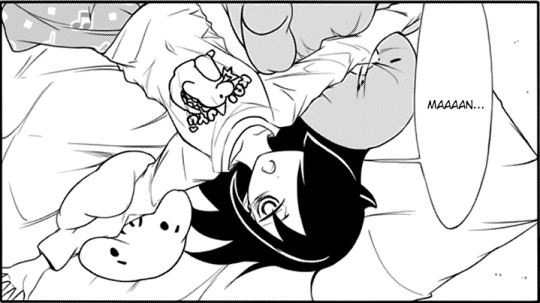
The things that Stuffed Yuu-chan and Pals have seen...
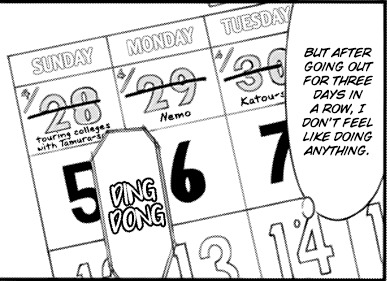
Ah, the classic Introvert Burnout. I had a feeling Tomoko would be drained after having what may have been the most socially stressful time of her life. Not simply for being social, but for how much she had to navigate as a fish out of water. Each “date” involved a new experience for Tomoko to address, and that much effort at once can be really exhausting for a layabout like her.

That my friend is what we in the TvTropes community call, “Tempting Fate”.

Heeeeeere’s Kii-chan!
Can’t even begin to tell you how much I love this entrance. We all know who Kii-chan is. But even those outside of the loop would get a feel for who she is. Adorable and sweet-natured, but disturbing due to an apparent lack of negative emotions (even when appropriate). Ah, Kii-chan, it’s been far too long.

Nothing to say here, really. Just think it’s a particularly lovely picture of Tomoko.

Because the popularity of a manga series is largely dependent on real-time reception, it’s very common for mangakas to add new, “popular” characters, or give the spotlight to characters who’ve been out of focus. Watamote is no exception. It may seem contrived to bring Kii-chan back after being gone for a while, but it works here because it relies on Kii-chan’s character to it, instead of a series of implausible plot developments. Kii-chan is just considerate of her cousin’s schedule–that’s all we need.
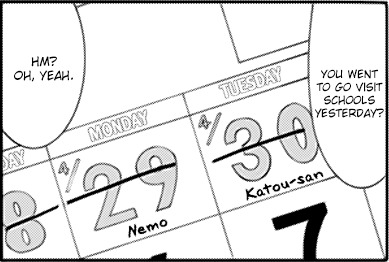
The first hint of Tomoko’s reawakening as the role model onee-chan.

One of the perks of being a sporadically-appearing character is that you can really see just much the art style has evolved since the character’s last appearance. For Kii-chan, she hasn’t really changed much design-wise other than being a little taller. But even then, the linework is much cleaner and consistent this time around, which compliments the more “everyday slice-of-life” approach Watamote’s been embracing.
If only she could grow a nose.
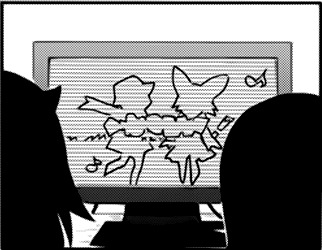
The best thing about this type of censorship is that you don’t necessarily have to understand what's being censored. All you really need is a bit of context to put the pieces together. The outlines are detailed enough that we can see the characters as some kind of humanoids with animal features. And given what we know about Kii-chan, it makes perfect sense.
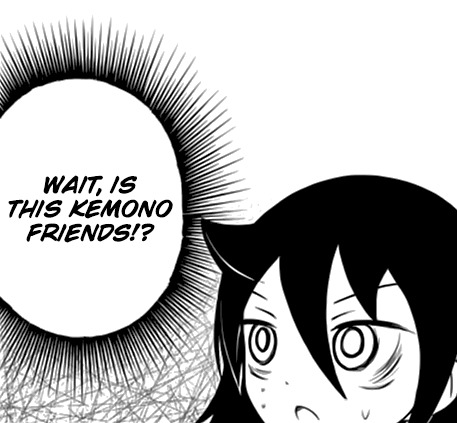
Y-Yeah, I...I’ve totally heard of that show.
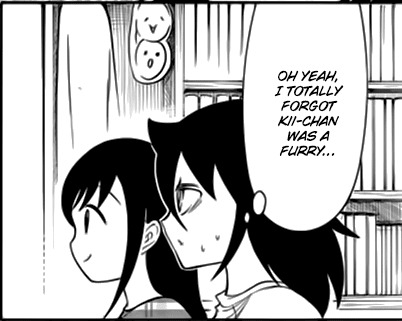
Other than the whole Ucchi situation (which is slowly becoming an unintentional blessing), this is the last of the misunderstandings that still needs resolving. It’ll be hard, though, since this particular issue isn’t that troublesome. For now...

Look at that platonic sibling bonding.
Perhaps I’ve been conditioned by manga/anime, but I find it refreshing how Watamote has managed to develop the Kuroki siblings’ relationship while avoiding any incestual subtext. Lots of series oversell the sibling relationship by having them be overly affectionate and clingy. With Watamote, their bond feels organic because they don’t have to be touchy-feely. An unspoken quality time is all there is to it.
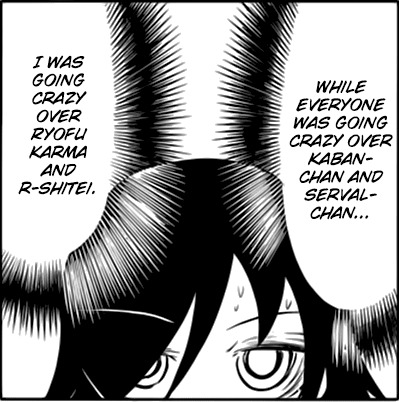
It’s hard to get a read on Tomoko’s emotions here, but at the very least, she seems troubled. It could very well be that Tomoko just realized that she’s changing in regards to the media she consumes. The former her would’ve probably jumped on the Kemono Friends bandwagon, but the reality is, Tomoko’s otaku interests are being compromised by the mainstream, at least as mainstream as rap battles get.
But the kicker is...she realizes this change isn’t all that bad.

Of course, nothing beats watching anime with your psychotic cousin.
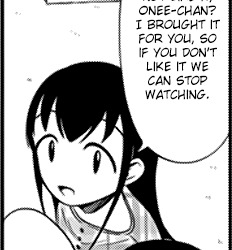
The whole “pet-sitting” relationship they have here is a tricky one since each side is trying to accommodate the other based on “flaws” that don’t exist (or no longer exist). This usually results in an endless cycle of misunderstandings that lead to nowhere, but this confusion has transcended that cycle to develop into a progression of sorts. Similar to the Ucchi situation, the absurdity became so frequent that it just became reality. One that each side has been influenced greatly from.
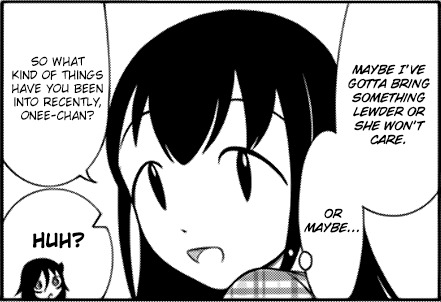
With her constantly adorable face, you forget that Kii-chan is a middle-schooler and is therefore old enough to know about things like sex and perversion. Like Yuu-chan, she may look innocent, and while she was aware of such things as a kid, she didn’t really get it until they approached high-school age.

You know, I read this really good manga called Kaguya-sama: Love is War (shameless plug, I know), and they actually had a chapter about a rap battle a while back. Given that both series tend to be up-to-date on contemporary trends, it makes me wonder...has rap suddenly become a hot thing in Japan? Or has it always had its niche audience?
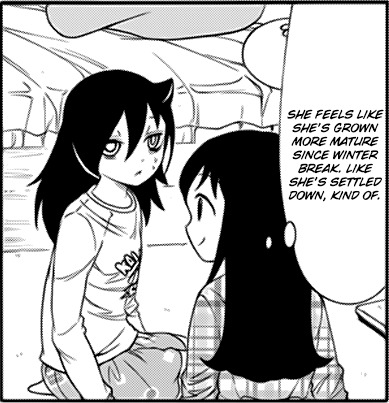
I’m sure many fans knew that this was going to be an inevitable development whenever Kii-chan showed up again. Unlike Tomoko’s school friends, Kii-chan wasn’t there to see the slow, gradual growth of Tomoko’s character, so it must have hit her like a ton of bricks to see her precious onee-chan go from helpless loner to mature teen in the blink of an eye.
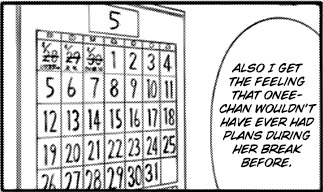
Sometimes I wonder just how pitiful Kii-chan thought Tomoko really was...
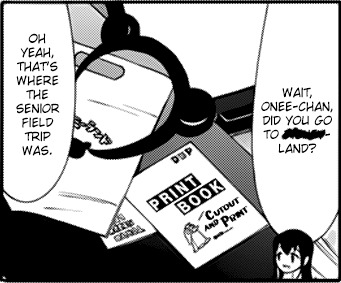
Why would you censor Disneyland now of all times?

Those of us who were clamoring to get close-ups of the photos taken in the Disneyland arc finally get their wish.
The Kowarith photo is my favorite, even though two-thirds of the people in it are faking their asses off. While that may be my personal bias towards the Tomoko-Yoshida-Yuri trio, I think it reflects a better sense of kinship between the girls. The effort is there, phony as it is, to support each other in an awkward situation, which is fundamentally what the series is all about.
The assumedly Fireworks photo is also pleasing, make no mistake. You can definitely feel more genuine emotions (or lack thereof) being expressed than in the other photo. But this focuses more on the individual than how they work as a collective group, despite there being more people. The girls ultimately look like six different colored Skittles–part of the same package, but each unique.

Could this be the start of Kii-chan revitalizing her perception of Tomoko as a super popular girl? I sure hope so.

How ironic. Kii-chan’s perspective of Tomoko is starting to grow ever so gradually on the upside, whereas Tomoko’s perspective of Kii-chan grows more and more negative.
Hang on, is that supposed to be some fake Dragonite shirt? Neat.

At this point, people assuming that Yoshida as some kind of punk based on her looks is a dead horse of an issue. Some stereotypes exist for a reason, I suppose.

I see your game, Nico Tanigawa, using a deliberately vague line about “two girls” to make your readers overanalyze a single panel. All I have to say to that is that I am completely and utterly guilty.
One of the girls is probably Yuri, if only because she’s the only girl to appear in both photos. As for the second girl, your guess is as good as mine. I’m inclined to say Ucchi because if Kii-chan only has their appearances to go on, then Ucchi and her emoji-face make quite the impression.
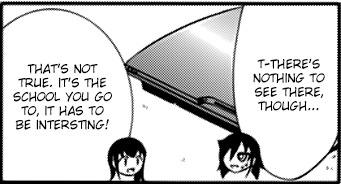
I’m getting Yuu-chan vibes here with the way Kii-chan phrases half-insults with a friendly demeanor.
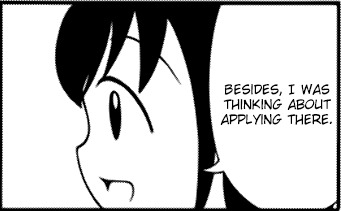
+ 1 TO THE HAREM.
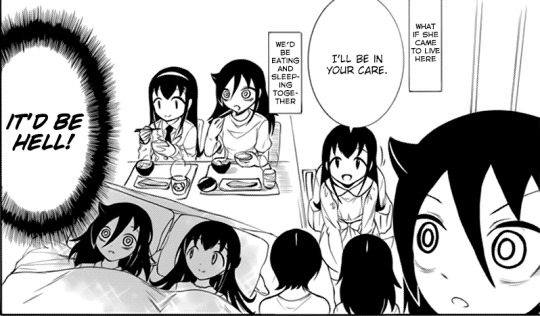
Kii-chan is definitely that relative you leave a self-imposed boundary on. Fine in small doses, like at parties and family gatherings, but long-term exposure is unhealthy for the brain. This isn’t even a wholly exaggerated fantasy on Tomoko’s part. Okay, the eating bit is a little much, but given that Kii-chan allegedly dreams about treating Tomoko like a pet, the latter is right to be a little concerned.

There needs to be an AU one-shot of Tomoko, Tomoki, and Kii all going to the same school at the same time. Right. Now.

I do appreciate that despite Kii-chan’s deteriorating sanity, Tomoko doesn’t view her as a lost cause and even tries to put a positive spin on it. Reconciliation Arc is a-go!
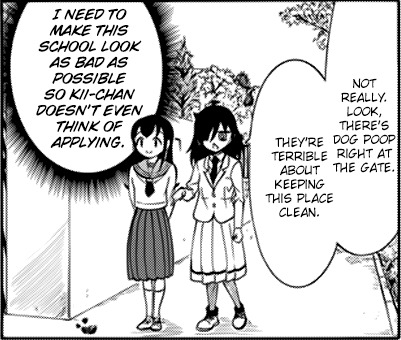
Did Kii-chan really have that big of a growth spurt, or has Tomoko just reached her peak in height? Not sure how far the genetics will go, but Kii-chan becoming taller than Tomoko is only going to make her even more intimidating.
This little scheme of hers is definitely reflective of the “old” Tomoko, but there’s a nice reversal going on here. Instead of Tomoko trying to make things sound cooler than they actually are, she’s trying to make things seem worse. Of course, Murphy’s Tomoko’s Law states that anything that can go wrong, will go wrong. Especially if Tomoko wants it to go right.

Ah, Ogino. The only character whose relationship with Tomoko has remained relatively unchanged despite indirectly having the most impact on Tomoko’s life.

Better update her Wiki page now.
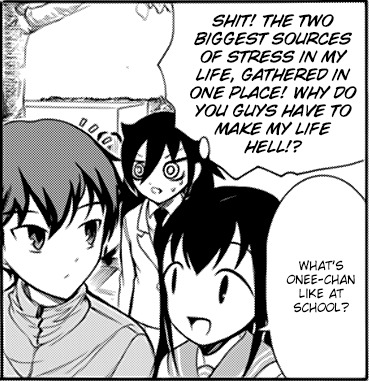
It’s pretty telling how it’s these two who cause Tomoko the most grief. It’s not the delinquent who routinely bashes her face in, not the pervert(s) lusting after her little brother, and not the otaku who passive-aggressively teases her. As for why, I think it boils down to the fact that Ogino and Kii-chan challenge her comfort zone the most. It also doesn’t help that Tomoko doesn’t interact with them as often as the others, so she hasn’t really had the time to get desensitized by them.

This freakin’ teacher, man.

The second worst part of Ogino’s “help” is that she never actually lies. Sure, she exaggerates to hell and back, but it’s always loosely based in reality, like some cheap movie adaptation of a best-selling novel.
But the worst part of it is...you can’t hate Ogino for it. Her personal assessment may be founded on largely suspect reasons, but it’s still an honest assessment. I have no doubts that Ogino really is proud of Tomoko, and that’s exactly why she’s the best worst teacher.
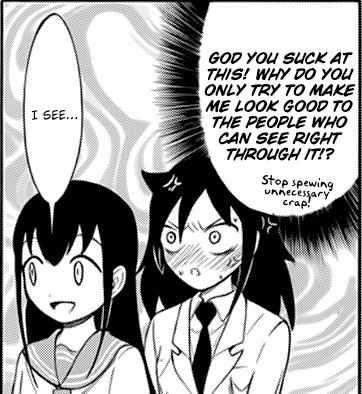
That’s true. If Ogino gave that spiel to people like Hijirisawa or Hatsushiba–y’know, people who don’t know her as well–they might actually buy that crap. But people who know Tomoko like Yuri or Nemo, people like us, can tell that Ogino’s sugarcoating the whole thing. Kii-chan, with her terrifying skill for knowing too much, is no exception.
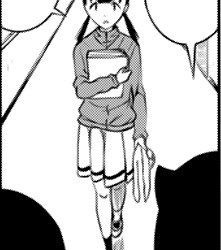
Ah, I see. This is one of those put-all-the-secondary-characters-who-we-haven’t-seen-in-a-while-into-one-chapter chapters.
Can’t complain, though. I like Itou.

“Or something” can also be translated as “lust after Tomoki”.
We don’t really have much to go on for how Itou views Tomoko, but I think it’s reasonable to think that she may not see her in that good of a light. Not only did Tomoko give off a weird impression when she played off the whole fist bump thing, but Itou’s “powers of perception” probably made her aware of Tomoko and Komiyama’s frenemy-ship, hence her “warning” that Komiyama was around.

The Inherent Awkwardness of Second-hand Relationships: The Life of Tomoko.
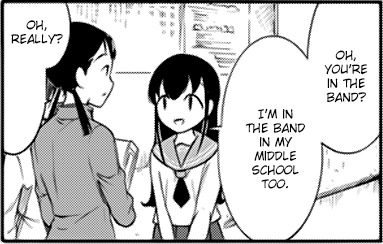
Betcha’ no one saw this interaction coming. Whether it’ll lead to anything more remains to be seen. Itou’s still got the whole “friendship potential” going on with Futaki, but given that she has the tolerance to BFF Komiyama, I see no reason why she can’t befriend a psycho like Kii-chan.

That desire to “loudly blow” is Kii-chan’s inner demons screeching out in desperation for release. I pity the fool who unleashes the beast.
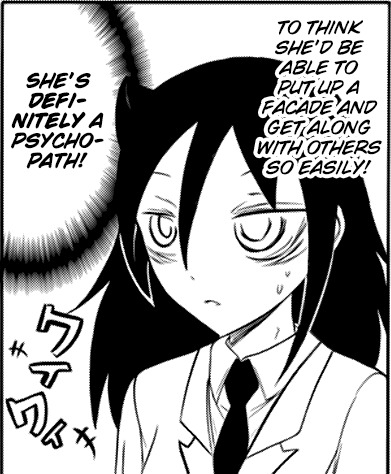
That does sound like your typical amateur definition of a psychopath, doesn’t it?
For the record, I don’t actually believe Kii-chan is a psychopath, despite the jokes I made. There are way too many moments that discredit such a claim. Now, if you were to accuse Kii-chan as being some sort of deviant (sexual or otherwise) I might see that. But ultimately, I think Kii-chan was just a victim of having her innocence shattered too fast and too soon, which made her more, uh, crafty than Tomoko could handle.

Man, it’s been a long time while since we last saw Dicky-chan, hasn’t it? Hope we get to see more of her (and Sayaka, for that matter) after this chapter.
I love how even when she’s collecting masturbation material, Komiyama has to hold her camera phone all lady-like. If the term “purevert” ever needed a concrete definition, this girl would be it.
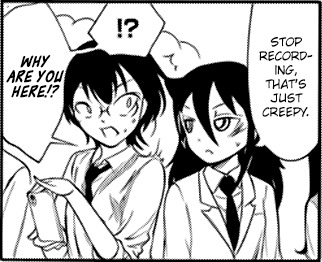
Main Character privileges, that’s why.

Get. The. FUCK. Out. Of. Here.
With each subsequent appearance, Komiyama’s standard for what constitutes a bitch primed to steal away her Tomoki-kun falls hilariously lower. It’s not enough that a girl in their class makes two seconds of eye contact with him, nosiree. Any girl with an inkling of a relationship with Tomoko is not immune, even if it’s his own damn cousin. Granted, I don’t think Komiyama would be so pathetically scummy as to confront Kii-chan about it like she did to Yoshida.
...I hope.

“Best friends” may be stretching it now that we’ve gotten this far in the series. However, there is one aspect of Tomoko and Komiyama’s relationship that triumphs over all the others:
Absolute candidness. Even now, the only one who gets to see the complete, raw package that is Tomoko Kuroki is Komi-something. While Tomoko has made substantial friendships with the likes of Yuri, Nemo, and Katou, Tomoko still restrains herself just a tad lest she pushes them away. It’s only with Komi that Tomoko bears her full ugliness, which I think has developed into some freakish level of respect/understanding that none of the others can claim.

Damn, even the bishounen dude gets to make an appearance. All we need know is Lethal Chef Girl to make a cameo and I’m set.

Nope. Any game is an away game when your “harem” shows up to cheer you on.
A few people have expressed discontent with how the chapter seems to end so abruptly, and it’s a fair criticism. It may be the lack of a “Next time...” tagline throwing people off, but while this chapter indeed ends at an odd point, it’s not that unprecedented. Some of the previous chapters ended this way, like that time Komi was all “Oi!” at Yoshida at the cafeteria, which indicates that this chapter is likely one of those series-of-vignettes that also doubles as a build-up chapter.
On a positive note, while the chapter does feel prematurely ended, how the next chapter plays out if it is connected to this one is sure to be a surprise.
#watamote#watamote review#chapter 141#no matter how i look at it it's you guys' fault i'm not popular!#tomoko kuroki#kiko satozaki#ogino#itou#kotomi komiyama#akari iguchi#tomoki kuroki#that one bishounen dude#review
29 notes
·
View notes
Text
the one good thing is the thing no-one ever talks about (”The Fault in Our Stars”, #1)
There are stories I enjoy entirely, and I usually don’t feel the need to lapse pseudo-intellectual about them. They’re usually either animated or hand-drawn, because my brain, it appears, has Standards for some media but not for other. Sure, I just finished re-reading one of the worse perpetrators of literate expressionism so deeply steeped in Jung that nary a word in it is to be taken literally, and maybe part of the reason I didn’t feel like going like this about that was because I know I’m not learned enough for it. Contemporary teenage fiction? Oh for sure, that I can try to sound clever about. The telling irony, of course, is that I plowed through “The Fault in Our Stars” in something like 48 hours, while “Demian” took me a solid ten months, going by goodread stats. Yet here I am, prepared to sound all condescending about adult readers singing the praises of non-fantasy YA because literature, by god, should not be simple. But “plowing through it” doesn’t mean “being particularly entertained by it”; at best, it was easy and I wasn’t bored, but it left me with two things: I can finally cross it of the “should probably read it because everyone else has” list, and one book down on my Goodreads reading challenge.
Point being, I’m pretty sure “Emily’s Quest” isn’t qualitatively better except for its pretty prose, but that one didn’t prompt me into something like this. And that one I sincerely did enjoy reading.
Keep in mind that all of the below amounts to me being twice the age of the intended readership, and also that I’ve graded some four or five high school papers poorly discussing the book-to-film adaptation. I knew how this tale ended before going in; it probably didn’t ever stand a chance. It could’ve surpised me, but that was a hope mostly in vain.
“This is not a cancer book because cancer books are sentimental, pseudo-inspriational garbage” goes its mission statement per our tired teenage narrator, but inspirational sentimentalism is what this amounts to, if veiled by some thin attempts at naturalism. (a terminally ill person loses control of body functions, lord allmighty what a shocker that must’ve been in a country that can’t handle female nipples) It’s got as happy an ending as a book about lovers parted by death can have, because this is for kids, harmony must be maintained, leave them the hope. It’s not bad, but from an adult perspective (at least the adult forced into reading Difficult Books) it’s hardly memorable. Fwiw, it’s at least better than I remember “PS: I Love You” being.
What DID surprise me:
That Asshole Author was merely a device for getting Hazel and Gus into the Anne Frank house. Not in the “they finally kissed” sense, but because that first kiss meaningfully happens in the tangible memorial to said girl’s fate, autobiography and postmortal immortality.
For more comparisons to art none of you know: “Young Goethe In Love” and its ending credo that “poetry is more true than reality”. Said film, of course, is hardly truer to actual events than the novel whose conception it supposedly portrays, but that’s the point. The real story was a pathetic affaird but it inspired a fiction that became immortal - and isn’t being the bedside reading of Napoelon and Frankenstein’s monster more important, in the end, than the disappointment of moving on from a tragic first love?
People smarter than me who have read Anne Frank’s diary after the age of twelve can probably say something intelligent about whether her writing is interesting on its own merit or merely as a documentary of her tragedy. The question of what makes a story famous is irrelevant in the big picture, but in the context of this book and its meta-discussion of fame and immortality, does become important.
Gus, per his own admission, isn’t much of an author: the one story he aspires to write, he never does. Like the rest of his life, what remains of his writing is entirely unknown and inconsequential, except that it touches the hearts of the two people he wanted it to touch. Would he have stood a chance of fame if he’d chronicled his disease like Anne Frank did her imprisonment? This is entirely anecdotal, but in the years before this book was filmed, a great hit among the same readership where I’m from was the bound and published blog of an eighteen year old who died from cancer. No-one remembers her today, of course; to borrow the book’s own figurative language, cancer is a war that is fought every day, and it can’t be won by the Soviets marching into Berlin. Anne is history, Gus is everyday life; of course his tragic end will be forgotten once the people whose heart he personally touched have passed on. The vital question is: Would Anne Frank’s diary had been at all remembered, had she lived? I deeply suspect it would at best have survived as a historical testimony cited by textbooks.
“We’ll remain together forever - not in reality, but in the story” is how the fictional Lotte Buff of “Goethe!” explains the equally fictive depiction of a very real author. The statement is rife with irony, because if Goethe’s book in the film is meant to correspond to the book the real man wrote, they obviously weren’t together in that one, either. What survived wasn’t their love; it was their tragedy, but it was made immortal when it was translated from autobiography to art.
The Anne Frank House is also where Hazel defies her illness, in a moment of ephemeral triumph, and where the fame of her tale reaches its climax as tension is resolved and our star-crossed lovers, for an equally brief while, come together. The Girl Who Died So That Her Life Could Live becomes the frame of this deliberation on the powers of fiction, because Augustus Waters becomes immortal not in his own universe, but because his tragedy touched the hearts of a generation of teenage girls reading his story.
1 note
·
View note
Text
Celebrity designers, context collapse, and rethinking how I teach design history
My first typography professor loved introducing us to her favorite designers. I remember learning about Paula Scher, Stefan Sagmeister, Milton Glaser, Neville Brody, and David Carson in that class. (She loved David Carson! We saw a lot of his work that semester — this was the mid-2000s, Sagmeister was at the height of his career and the shadow of Carson still loomed.) She wanted us to see work from history, as well as the contemporary work she found exciting so that it could inspire, inform, and guide our own work. Looking at the earliest work I did in school, you can see what designers had caught my interest at various points in my undergraduate career: the Vignelli phase came first, then it was Pentagram. By junior year, I was interested in illustration, and my work looked like Charley Harper's and Frank Chimero's. I had an infographic phase inspired by Nicholas Felton and an embarrassing handlettering period that mostly resulted in bad Jessica Hische knock-offs.
My classmates were the same way. There was a group of us who closely followed design blogs, tracking the 'celebrity designers' of the time. Some of us even got really excited by the two required design history surveys, saving images to our pre-Pinterest inspiration files and trying on the styles of different designers likes costumes. I remember one student particularly well who, following the lecture on Art Nouveau, decided he was going to make every project look like an Alphonse Mucha poster for the rest of the semester. I still cringe at the Russian-Constructivist-inspired poster I designed for a school function. We named dropped in critiques, showing off with our knowledge of history or our awareness of the trendy designers of the moment, completely unaware that half the class was rolling their eyes. For myself and my friends, it felt like part of being a good designer was knowing those names.
When I found myself back in the classroom — nearly a decade later, this time as the teacher — I was surprised to find how many of my students, at every level, had little sense of the history of graphic design, not to mention the 'celebrity designers' of today. Design history is largely foreign to them; it's an optional course in many design programs. It's rare for a student to know Sagmeister, Carson, and Scher (or Rudnick, Hu, and Walsh) if I mention one in class. I once had an upper level student who had never heard of Pentagram. Pentagram!
It's not that this generation of designers isn't consuming design media but the way they do is wildly different than when I was in school. At their age, we read blogs to find out who was doing the most interesting work, but those don't exist anymore. My students aren't reading It's Nice That or Eye on Design. They are on Instagram, on Behance, on Pinterest. Their design awareness, sensibilities, and taste is constructed through likes, pins, and retweets. They might not know the name Michael Bierut or have heard of Wolff Olins but they've seen the work. And they've also seen work from countless other designers flying below the mainstream design press radar.
Consuming design this way creates a peculiar context collapse. Everything moves fast, the thumb occasionally pausing for a closer look, where work from an international branding agency can sit next to a great poster by a high school student in India. These images travel from board to board, retweet to retweet, ever so slowly removing any sense of where it came from — the designer is often anonymous, the subject matter irrelevant. A quick tap saves it and then it's on to the next image. My students don't know the names of designers or agencies or studios but they do know what's trending, the popular styles, and the latest rebrand. Eventually, all the work starts to look the same.
Kids these days, I caught myself thinking. I had become the cranky old man complaining about how the next generation doesn't understand it sooner than I had thought I would. I mean, I'm only thirty and here I was worried about what this meant for the future. It was better when I was in school, I thought.
But what if this isn't necessarily a bad thing? Maybe this is an opportunity to teach design history and culture another way. Maybe it's a good thing for the idea of the 'celebrity designer' to die. The myth of the solo genius, alone in his studio, doesn't work anymore, and far too often it continues to only elevate the white male designer. Design conferences continue to feature the same designers year after year, sometimes even when at least one of those designers probably deserves to be cancelled. This perpetuates a particular idea of what a successful designer looks like and what makes for 'good design'.
Whether intended or not, the images my undergraduate professors showed us became the standard by which we judged design, and the names attached subconsciously became the people we were supposed to be emulating. The design history courses I took a decade ago were surveys: the professor would click through images on the screen in the front of the room; a list of names and styles we had to memorize. We spent little time talking about the content or articulating the context it sits within. Like my students now, I would get excited by something else I saw and use it in my own projects, regardless of context or content. Where we knew names, they know styles. Is one of these really worse than the other?
To be clear: this is not to say that names shouldn't be attached to the work or that we should disregard history. I believe these to be important elements of any design education. But inspiration is not enough. Trends are not enough. Simply collecting images is not enough. To move beyond inspiration, to dig deeper than trends and avoid celebrity design culture, we must make space for our students to reflect on this work and think about how it connects to their own blossoming practices.
In every class I teach, at both the undergraduate and graduate level, I've started requiring students to keep a visual journal — a dedicated place to keep images, PDFs, videos, photos — a simple attempt to encourage them to be more thoughtful about what they are consuming and saving. I try to build time into class for students to reflect on the work they are finding, and at the same time, I'm sharing the things I'm looking at and thinking about. (And I make it clear that what I share isn't always an endorsement.) Together we try to figure out why we are drawn to these things. Or repulsed by them. Or why they are trending. Or where they come from. We talk as a group about art movements and trends and gaps in history. We lean into the aesthetics, the contexts, the politics, and the ideologies that may or may not be embedded in the work. We dissect the visual moves the designer did and why she may have made those decisions. We find out more about the designer, of course, but we let the work speak for itself. Just because it came from a particular designer or a particular studio doesn't mean it's automatically great. Some of the best moments I've had in the classroom are when the students start debating these ideas — amongst themselves, without any guidance from me — trying to formulate their own point of view.
I want to create a space for young designers to feel comfortable conducting a thoughtful interrogation of images, visual culture, and the very profession they are about to enter — perhaps a small step in dismantling the celebrity designer complex while moving beyond the trends of their time. Looking at other design will always be central to the young designer's process, but they should't feel bound to trends, to styles, to celebrity as they move through their careers. The problem isn't that students don't know designers' names or are blindly following trends, it's that it is all moving too fast. Instead of fighting the new consumption paradigms, I've started to embrace it. Where I once looked down on these new modes of consuming media, romanticizing my own college experience, I now see the design students today as better equipped to do this work than I was at their age. They are well-versed in reading images, fluent in media literacy, and far less interested in celebrity. They get to experience more design — from all across the world — than any previous generation. If any of us can move beyond celebrity and dig deeper than the latest trend, it is them. We just need to be sure they have the critical tools, along with space and time, to do this work. The kids, I'm beginning to think, will be alright.
2 notes
·
View notes
Text
How to Do Nothing: Jenny Odell's case for resisting "The Attention Economy"

Artist and writer Jenny Odell (previously) is justifiably beloved for her pieces and installations that make us consider the economics and meanings of garbage, weird markets, and other 21st century plagues; in her first book, How To Do Nothing: Resisting the Attention Economy, Odell draws on art criticism, indigenous practices, "Deep Listening," anti-capitalist theory, and psychology to make the case that the internal chaos we feel is no accident: it's the result of someone's business-model, and until we reject "productivity" in favor of contemplation and deliberation, it will only get worse.
Odell's central thesis is hard to pin down; part of her subject-matter here is that really important ideas don't neatly distill down to short, punchy summaries or slogans -- instead, they occupy a kind of irreducible, liminal complexity that has to be lived as much as discussed.
With that in mind, the broad strokes of her book are that:
* The rise of "productivity" as a measure of the quality of life is incredibly destructive, and it obliterates everything inside and outside of us that make us happy, because sleep and love and laughter and beauty are not "productive."
Odell links this to neoliberal capitalism, and the requirement that each of us be a hustling entrepreneur, which, in turn, is a way for capital to shift risk onto labor. It's a scam that moves both wealth and joy off of our balance sheets and onto the balance sheets of the super-rich.
This is very strong material, and it reminds me of the one conversation I had with David Allen, author of "Getting Things Done." Allen lamented that everyone pays close attention to the first two parts of his book (which focus on making sure that the stuff you decide to do get done) and skip over the third part (which focuses on deciding what to do).
* That doing "nothing" doesn't mean becoming a hermit: it requires more social engagement, not less
Odell builds on the idea that capitalism atomizes us and makes us stand alone and think about our relations to others in instrumental, individualistic terms; the reason social media is toxic isn't that it connects us with others, it's how it connects us with others. Doing "nothing" (that is, spending your time doing "meaningful," rather than "productive" things) requires that we find ways to genuinely interact with others.
This reminded me strongly of Patrick Ball's incredible essay on depression and suicide, and the reason that affluent white dudes are the most suicidal people in America today. Ball's thesis is that people who lack privilege must forge social relations with the people around them just to survive. If you have no money for a babysitter, you can substitute favors from friends.
"Favors from friends" are unreliable and nondeterministic, while spending cash with a sitter (or better, a service that has many interchangeable sitters) is extremely reliable. But if you keep substituting transactions for social networks, you'll eventually end up lonely and outside of any kind of social group that can form a resilient mesh for your inevitable problems: there's no one to put a hand on your shoulder, look you in the eyes, and say, "Are you all right? You seem to be in trouble."
Reading Ball's essay made me realize how much of a hermit I'd become, substituting work and transactions and "productivity" for friendship and connection, and how much of the anxiety and depression I was experiencing was the result of this isolation.
Social media is a great way to stay in touch with the people who matter to me, so that we can have offline, longer-form, important and meaningful interactions. But the commercial imperatives of social media work against that kind of socializing, because once you get together and start to have those contemplative and meaningful interactions, your social telephone starts ringing, because the algorithms that govern it notice that you're not paying attention to it anymore.
* That refusing to pay attention is an act with a long and honorable history
Odell traces the traditions of refusal from the ancient Greeks to avant-garde artists, and connects these to feminism and liberation struggles. This was fascinating context, and often very funny, and felt like something of a masterclass in understanding abstract art as well
* That cities have unique properties that make them hubs of resistance
The struggle against our reduction into productive workforce units, as opposed to thriving, contemplating, loving humans is the struggle against monoculture. Cities, with their diversity of people, backgrounds, incomes, social situations, and so on are the perfect place to resist monoculture. Places where strangers mix, like public transit, are hotbeds of resistance.
Odell also lauds "third places" here, the places that are outside the market, like libraries and parks, where your welcome is not dependent on your productive contributions, which ask nothing of you except that you be there.
And even as Odell is praising cities here, she's also working in a strong environmental message, connecting refusal to indigenous practices of attentive co-existence with the natural world, and connecting that to the complex idea of "bioregionalism," which involves identifying as a person whose place matters, whose views on the world and daily activities are influenced by the things that grow and thrive around you.
I've been around "bioregionalism" advocates for much of my life, and I admit I still struggle with some of the nuance of this idea, but Odell's connection feels right, and I really enjoyed the way she connected the beauty of cities -- which I love -- with an appreciation of, and connection to, the natural world.
* That technology isn't the problem, but rather, its economic and political context are what get us in trouble
This is the argument that puts Odell in the same group as some of my other favorite thinkers, like Leigh Phillips, Paul Mason, and Peter Frase.
Like the others, Odell doesn't argue the simple position that technology is neutral, but rather takes the position that technology's current decidedly partisan configuration is the result (and not the cause) of market ideology that demands growth, consumption and "engagement" instead of joy, meaning and peace.
It's an important point: Odell isn't telling us to stop using technology, but to use different technology in different ways.
There is so much to love about this book: Odell's discursive, interdisciplinary critique approaches an important and difficult question from many different angles, making it a chewy, provocative pleasure of a book.
But all that said, I'm looking forward to her next book. I know from my own work that what feels like irreducible complexity is often a lack of clarity. That is, just because you think you've made something as clear and simple as it can be, it doesn't mean you're right, it might just mean that you don't understand your own material well enough, and have not spent enough time trying to explain it to other people in order to learn what parts of it are important and which parts can be left to one side.
As much as I love this book, I also think that there is room to make it crisper, and some of that room will come from Odell gaining clarity as she tours with and discusses these ideas, and some of it will come from the rest of the world catching up with her -- when we started talking about online privacy, there was a lot of getting-up-to-speed that had to happen before the discussion could start. Today, the baseline of familiarity that others have with the ideas is much farther along, and so the discourse is more substantial and less about getting on the same page (this is also true of other complicated debates, including the contemporary critique of capitalism and concerns over climate change).
That's not to say that Odell has fallen into the trap of the masochistic longread ("because paying close attention to complicated ideas is a virtue, I will simply write this idea out in sprawling and undisciplined form, because the longer it is, the more virtue it has"). This book never bores. However, it does leave the reader with more feelings (which are good and important!) than clear articulation (also good and important!), and I think that Odell's continuing trailblazing will find a place where these two virtues are more in balance.
How To Do Nothing: Resisting the Attention Economy [Jenny Odell/Melville House]
https://boingboing.net/2019/04/09/resisting-attention-economy.html
48 notes
·
View notes